#lizard’s continued attempts at Japanese
Text
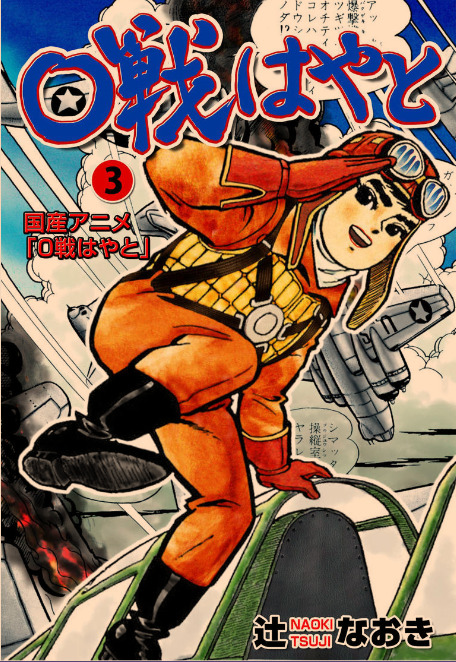
0-Sen Hayato - Volume 3
It feels like it took me a whole year to get through this one lol. It's boring, but not the worst thing I've ever read. Sometimes something spicy will happen (like someone dying or the romance side plot inches forward) and that's enough to keep me going.
Ch. 23
-In this chapter the gang tries to blow off some steam by goofing off and dancing (and getting drunk) but then their superior's superior comes in and chews them out. Hayato and Ishikawa get exiled (?) and sent to the jungle where they run into "a ghost." Meanwhile, the Americans plot their attack.
Ch. 24
-Hayato and Ishikawa find Ishiki in the woods wounded and bring him back to camp despite being exiled. Ishiki warns them about the encroaching enemy and then we cut to some sort of D-Day-esque scenario on the beach. The squad isn't allowed to participate in the battle because their territory is the skies, so they just watch on.
Ch. 25
-The boys continue to scramble to kill themselves for their country and for glory...this is seriously the least relatable thing I've ever read lol
-I don't really get how war works. If the air force can just attack the people on the ground, why didn't they just always do that? Lack of resources maybe? It kinda seems like an OP tactic...
Ch. 26
-This chapter was WILD. Hayato convinces the gang to kill a bunch of monitor lizards and dump their blood in the ocean. Then when the bad guys (Americans probably) attempted to storm the beach a bunch of sharks gathered and ate them all. That's wacky enough, but then they said that 10,000 soldiers were eaten!? Wtf...not possible. (I googled this and apparently there was a WWII incident where an American ship sank and 890 people were left in shark infested waters, probably the closest thing irl to this manga's ridiculousness).
-This manga has an anti-kamikaze stance, but it also shows its heroes as constantly ready and eager to die for Japan so...mixed signals.
Ch. 27
-I kinda liked this one, at least we got to meet Ishiki's sister (now a nurse). Of course everyone instantly has a crush on her because they're women-starved
-Wtf was up with the "muu" grass? It was strangely magical, like a tentacle monster? I guess since the last chapter jumped the shark (hehe) they feel like they can get away with this magical realism BS.
-Ishiki is WAY too committed to his rival bit. Someone needs to smack some common sense into him before he gets himself killed for real.
Ch. 28
-Ishiki continues to act recklessly, but I guess he's just getting away with it for now? Not sure if he just figured out how to compensate for his bad eye or if he got lucky and something bad will happen in the future...
-I think Hayato's dad just died? Hard for me to tell cuz all middle aged men look identical to me. Hayato did say "I sense a disturbance in the force" (paraphrasing). So I'm probably right. That seems like a pretty major character death for this series so I was a little taken aback!
Ch. 29
-Okay phew, I got it right. In this chapter Hayato finds out about his father's death and inherits his plane and katana. I thought the emotion of it all was handled pretty well without going into any melodrama. Since soldiers sign up knowing they might die (especially Japanese soldiers in WII) they'll probably react more stoically to that kind of news.
-We find out that it was the King Satan airplane that shot down Hayato's dad, because of course it was. Gotta give more fuel to the silly rivals plot. Ishiki acts like a douchebag again and is like "sorry about your dad, but I'm gonna make this about ME" lol. At least I can laugh at how cartoonishly shitty he is.
Ch. 30
-Hayato tries to figure out how to operate his Dad's plane which is "different from other Zero airplanes" (or whatever you call those in English). I didn't really get what he was saying about it, but I figured I probably wouldn't get it in English either so it's fine lol
-We get to see the nurse girls again which is always nice. The chubby one with braids is adorable. Of course they made each girl have a crush on their male counterpart (chubby girl likes chubby guy, skinny girl with a hooked nose likes the dude with a hooked nose, etc.) Whatever, there's so little body diversity in anime girls nowadays that seeing this lil bit of variety is refreshing.
Ch. 31
-The Bakufuutai's rival squad (the Shiuntai) get 35 new pilots but they are very inexperienced (only 150 hours of flight training). The Bakufuutai tries to be good senpai and stop them from flying recklessly, but the Shiuntai's leader is being a jerk as usual and tells them they can't tell his squad what to do. I should probably learn that guy's name lol.
-The hairy dude with big lips gets his own big lipped girl who's in love with him. Unfortunately they used this as an opportunity to make her "ugliness" a joke. Hey! If dudes are allowed to look funky girls should be allowed too >:/
Ch. 32
-This chapter was far too dialogue heavy and I barely followed what was happening. All I got was that Hayato and Ishiki were begging their leaders to not send the newbies off on a mission and then Hayato and friends end up being sent off to Manila for some reason. The nurse love interest creepily talks about being prepared to die a bunch...
5 notes
·
View notes
Text
Drummer Lucy M. will forever live rent free in my head. She'd be so cool, and pretty I love her. She would start taking lessons from an early age, taking her time until she could play it like second nature. Mark would've taken two weeks of lessons alongside her (shhh ik it won't make sense given the timeline and how they would probably still be in Canada, and a town near the Mississippi but shhh) because he thought it'd make him look cool, but gave up too soon, and went on to be an amazing self proclaimed musician, trying multiple genres because he can't choose one (he's actually has pretty good vocal range, but his ego is infuriating to those close to him. His outfits are usually made for fan service, and Lucy, his twin in everything but blood, makes fun of him 'You look like a hotdog mascot abshshksb'.)
Atsushi would look so good with a saxophone. He'd be under training for a while since his skills are pretty rusty at best, but his potential is there, with Fukuzawa, and Naomi having complete faith in him from the start. He gets his debut a few months later. His signature haircut grows out a little until it looked decent (looks like the one in beast), he usually wore caps, hoods, a hat like tricky's from subway surfers, or maybe have it pulled back with multiple bobby pins. His popularity skyrockets after a few performances, and let me tell you the people love this albino.
The Guild productions™ is an international agency with it's main branch in America, they attempted to recruit Atsushi into their ranks, using underhanded tricks, nearly succeeding for a little over a week before their Japanese branch nearly went bankrupt, courtesy of souheki; they had to give up Atsushi, and Lucy left along with him to work as a barista in the Agency's favorite cafe, rumours about her are spreading like rapid fire, and she tries to act like she couldn't care less (She has had a little bit of a break down when too many people gave her judgemental stares at the grocery store.). Louisa A, the Guild's manager, manages to pull them, and the president, steadily rebuilding their reputation. They'll never go back to their prime days in Japan though.
The Violinists of the show would be Mōri, Dazai (former), Akutagawa (former), and Yōsano.
Akutagawa would've been a very capable violinist in the past, and continued to play despite Dazai's absence in hope of proving himself to him. Chūya, and Gin convinced him to try something different after gaining Dazai's approval (something like what happened during the guild arc), and that's when he found out how well he went with a trombone. Don't question it. He'd look great with one, and by now he's on the fast track to finishing his treatment and getting cured from his lung illness, because he's actually receiving medical attention (courtesy of the black lizard + Higuchi and Chūya, and the fact that it isn't as severe as canon.). I also read somewhere that playing brass instruments helps with the lungs or something.
I can definitely see Kōyō playing either a flute or a harp with the 'Black Port' orchestra, having the Japanese biwa as a side hobby.
Oda's voice would be such heaven on earth to listen to. He was originally a genius in the music industry, having worked with multiple choirs, and collaborating with multiple artists, yet preferring to be a soloist. However, one day, he up and left the entertainment world behind at the age of sixteen without so much as a notice, only to return as a backstage assistant in the 'Black Port' orchestra, not drawing any attention to himself, and refusing to do anything music related if anyone asked. He left that same orchestra after three years due to unknown reasons, though it was rumoured to be related to an agency called 'Mimic', and the maestro (and violinist) of said orchestra. Dazai Osamu, 'The Black Dove of the Port', went off the grid weeks after that. He isn't recognisable at first sight, but people eventually catch on as he debuts with an electric guitarist under one of the country's best agencies two years later. He would mentor the younger recruits from time to time.
Fyodor's Cello should become a fic name if it already isn't.
Kunikida would be an electric guitarist fight me.
Chūya would've be one of the best vocalists in the industry, being an on and off member with the 'Black Port' until he turned 15, officially joining as a snare drum player. He gets assigned to practice with a group that called themselves 'The Flags', they are still alive, happy, and well (I am definitely not escaping reality leave me alone). He was the former drummer, and lead singer with a band of outcast kids during his middle school years because I said so, and he attended lessons with Michizō because redheads solidarity. (Sheep disbanded teen rock band real?!)
Nathaniel might have basic knowledge of how to play an organ because why not??
Kyōka would be a natural pianist, a prodigy in the making, with Kōyō, and Atsushi fighting for the spot of 'biggest fan'. She was recruited by Atsushi despite Kōyō's complete refusal; she came around eventually, and started being more supportive of her growing on her own.
Kenji country music artist Miyazawa got scouted by Fukuzawa after watching him preform beautifully in the middle of a market. Everyone at the performance was smiling uncontrollably, even Fukuzawa being affected. He can play the ukulele, and a normal guitar too.
Yōsano would continue her violin career after quitting lessons with Mōri, but under Fukuzawa's agency. She was proud of her capability, and recognizing it as her own, still flinching slightly at the mention of her former mentor. (He didn't SA her get your mind out the gutter you weirdos, he was just too strict, and his methods weren't conventional, or suitable for eleven years olds)
Naomi is the agency's esteemed manager, and Haruno is Fukuzawa's direct secretary.
Rampo would be an enigma in his own right, one of the best directors that created revolutionary master pieces throughout the 21st century. The agency was founded to support his child acting career, and to serve as a somewhat safe home for him, before he decided to become a director. His reputation is a mix of good and bad, mostly speaking of his random schedules, and sweet tooth, but he couldn't care less. He only starts new projects when he's in the right mood, he's unpredictable like that. He's close friends with one of the Guild's members that specializes in mystery movies, specifically focused on psychological horror; they cause trouble together a lot despite how usually unsociable the latter is.
Jun'nichirō plays on the keyboard, and his audience loves his awkward + cute personality; he's besties with Atsushi, and is always either seen with him, or Kenji. The audience know of him having a sister, but overprotective big brother Juni would never allow her to appear on stage, much less allow the audience to know her name (no incest crap this is a slightly happier life without Abilities)
I could go on but I'm lazy :>
#bsd#bsd aus#crack au idea#bored rambling#saff-ron tag#bsd guild#bsd ada ensemble#bsd port mafia#entertainment industry au?#entertainment industry au#lucy maud montgomery#atsushi nakajima#akutagawa ryuunosuke#dazai osamu#oda sakunosuke#mark twain
1 note
·
View note
Text
Venator

Hunter 3d model © Capcom, accessed on the Resident Evil Wiki here
[Commissioned by @arachcobra. The Umbrella Corporation doesn’t know when to quit, does it? There’s a whole host of variant hunters, but they’re mostly worse than the original, or a lateral move at best. More powerful variants only exist in weird corners of continuity, like manga or a light gun game. I include info on two of them as variant monsters below; the gamma hunter is a different beast entirely, with protruding mouthparts and swallow whole, so would get a different statblock. The name “venator” is just Latin for “hunter”. It was either that or use the phonetic Japanese name for these monsters, hanta.]
Venator
CR 5 LE Monstrous Humanoid
This creature appears to be a hybrid of man and reptile, with a thick armored skin and long, clawed hands. Its face is mostly human, but has mere slits for nostrils, and sharp, triangular teeth. It has a thick neck with bony scutes running along its margins.
A venator is an artificial species, a hybrid of lizard, crocodile and human created through fleshwarping. The human form is most dominant physically, as venators have no snouts and no tails. Their mental capacity is less than that of the average human, but more than an animal—sufficient for taking orders and following directions, but with relatively little risk of initiative or rebellion. Most venators are found within the service of the fleshwarpers who created them, although some have escaped and gone feral.
Venators are trackers first and foremost, able to move at great speed while following a trail. Once they reach their quarry, they leap into combat, charging with their foreclaws. The most sophisticated tactics they are capable of are setting up flanking positions, and using their powerful roars to knock over enemies and hit them when they try to get up. They do not use ranged weapons, but can climb or swim over most obstacles between them and a ranged combatant. Venators almost always fight to the death unless ordered to retreat.
The venator is sometimes called the “alpha venator”, as the base stock has been altered multiple times in an attempt to improve its durability, speed or lethality. Few of these attempts have been successful, but the variants are still found in some dungeons and wizard towers. A beta venator has one elongated arm and greater reflexes, but its vision is impaired by tumors growing over its face and shoulders. Treat a beta venator as a venator with 10 foot reach for one claw, Dodge and Lightning Reflexes as bonus feats, but a 10% miss chance on all attacks. A beta venator is a CR 5 creature. An R venator has jagged claws that deal 1d4 points of bleed on a hit and gains Improved Sunder as a bonus feat, but gains vulnerability to cold. A R venator is a CR 5 creature.
Venator CR 5
XP 1,600
LE Medium monstrous humanoid
Init +8; Senses darkvision 60 ft., Perception +7
Defense
AC 18, touch 14, flat-footed 14 (+4 Dex, +4 natural)
hp 57 (6d10+24)
Fort +6, Ref +9, Will +6
Defensive Abilities fortification (25%)
Offense
Speed 50 ft.
Melee 2 claws +10 (1d4+4), bite +10 (1d6+4)
Special Attacks powerful charge (claw, 2d4+6), roar
Statistics
Str 19, Dex 19, Con 18, Int 6, Wis 13, Cha 5
Base Atk +6; CMB +10; CMD 24
Feats Combat Reflexes, Improved Initiative, Power Attack
Skills Acrobatics +7 (+15 when jumping), Climb +12, Perception +7, Survival +8 (+12 following tracks), Swim +12; Racial Modifier +4 Climb, +4 Swim, +4 Survival when tracking
Languages Common (cannot speak)
SQ swift tracker
Ecology
Environment any land or underground
Organization solitary, pair or pack (3-8)
Treasure incidental
Special Abilities
Roar (Ex) As a standard action once per minute, a venator can roar, causing all creatures in a 15 foot cone to succeed a DC 17 Fortitude save or fall prone. The save DC is Constitution based.
Swift Tracker (Ex) A venator can move at its normal speed while tracking without penalty. When it moves twice its speed in a round when following tracks, it only takes a -10 penalty instead of a -20.
27 notes
·
View notes
Text
Who Is Higuchi Ichiyou? (Spoilers if you haven’t fully watched/read Bungou Stray Dogs)
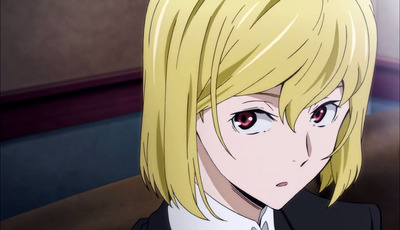
Higuchi Ichiyou, a port mafia member and the one who commands the Black Lizards. She isn’t respected by the mafia, she isn’t useful to the mafia ability wise but why is she here?
Let us begin from the beginning.
Who is the real life Higuchi Ichiyou?
She was born on May 2, 1872 in a nagaya (row house) on the premises of the Tokyo prefectural office (present Chiyoda Ward, Tokyo Prefecture) in Uchisaiwaicho, Ichi shoku, Daini daiku, Tokyo-fu (Tokyo Prefecture). Her real name was Natsu HIGUCHI. Her father was Tamenosuke (Noriyoshi) HIGUCHI and her mother was Ayame, the fifth daughter of the Furuya family; Ichiyo was their second daughter. She had an older sister (Fuji) and two older brothers (Sentaro and Toranosuke), and was followed by a younger sister (Kuni). Making Higuchi Ichiyou the fourth child.
Her father, Noriyoshi, was a peasant in Nakahagiwara Village, Yamanashi County, Kai Province (present Koshu City, formerly Enzan City). Her grandfather seems to have been familiar with creative writings such as haikai (seventeen-syllable verse) and keisho (the most important documents in Confucianism); it is said that Noriyoshi preferred academics to farming and, as his marriage with Ayame was not permitted, they practically eloped to Edo. Noriyoshi began as a servant in the Bansho shirabesho (a government-run Western studies education and research institute) and, by good fortune, became a jikisan (immediate retainer) of the bakufu (Japanese feudal government headed by a shogun) by buying a kabu (a right to become doshin) of doshin (a low-ranked official) in 1867. After the Meiji Restoration, he became a low-level official and acquired the status of shizoku (a family or person of samurai ancestry), but was dismissed in 1876. After that, he made a living by working as a real estate broker and similar things.
As a young child, Ichiyo was raised in a family of moderate means, and she enjoyed reading from the time she was small; she read kusazoshi (illustrated story books) and it is said that she read through "Nanso Hakkenden" (a story of eight samurai and a princess of the Satomi family in the Nanso region) by Bakin KYOKUTEI when she was seven years old. In 1877, she entered Hongo Shogakko (Hongo Elementary School), but could not continue because she was too young, so she enrolled in Yoshikawa Gakko (Yoshikawa School), which had been established privately by Tomikichi YOSHIKAWA. In 1881, Toranosuke, her second older brother, set up a branch family and apprenticed himself to an earthenware painter. The family moved to Okachimachi, Shitaya Ward in the same year, so in November, she transferred to Seikai Gakko, a private school, in Ueno Motokuromoncho. She graduated from the fourth grade of the advanced course at the top of her class, but left the school without advancing to the upper grades. It is said that this was because her mother, Ayame, believed that studies were unnecessary for women.
On the other hand, it is said that her father, Noriyoshi, recognized his daughter's literary talent and let her learn waka from his acquaintance, Shigeo WADA. In 1886, she entered the waka school 'Haginoya,' run by Utako NAKAJIMA, through an introduction by Choan TODA, an acquaintance of her father from the days of the Tokugawa shogunate. In this school, besides waka, she studied classic literature and Japanese calligraphy of the Chikage school; dynastic style literature, such as The Tale of Genji, was the motif of Ichiyo's early works. During her time at Haginoya, Ichiyo met her close friends Natsuko ITO and Tatsuko TANABE and gave lectures as an assistant teacher. At that time, Haginoya was a waka school attended by the wives and daughters of the former regime's privileged classes - such as court nobles, former roju (senior councilor of the Tokugawa shogunate), and former domain lords - and of the Meiji government statesmen and military personnel. Although Ichiyo was shizoku, since her family had been farmers, she was treated as a commoner; she became introverted, and senior pupils from the upper social class called her 'monotsutsumi no kimi' (literally, close-natured person). When the first annual New Year's opening ceremony since Ichiyo had entered the school drew near, the topic of conversation among the well-bred young ladies turned to clothing and festive dress, well beyond the range in which the daughter of a low-class government official could compete. However, she quashed her feelings of inferiority and attended the ceremony wearing old clothes that her parents had borrowed.
Ichiyo's family moved frequently; Ichiyo moved twelve times in her life. In 1888, Sentaro, the first son and head of the family, died; Ichiyo inherited the family and became its head, with her father as guardian. In 1889, Noriyoshi's attempt to establish an association of draying contractors failed, and he died in July of the same year.
Ichiyo's engagement to her fiance, Saburo SHIBUYA, was cancelled. It is said this was due to the fact that, although the Higuchi family was left with a large amount of debt after Noriyoshi's death, Saburo HIGUCHI required a large amount of yuinokin (betrothal [gift] money). At the age of 17, Ichiyo was forced to support her family as its head and, in 1890, she lived in the house of the Nakajima family as a Haginoya apprentice. In September of the same year, she moved to Kikuzaka, Hongo (Bunkyo Ward, Tokyo Prefecture) and, along with her mother and younger sister, was obliged to live a hard life doing needlework and araihari (washing, stretching and drying various parts of kimono). It is said, however, that Ichiyo herself tended to disdain labor, and that the needlework and araihari were conducted by her mother and younger sister.
As Ichiyo's nearsightedness made her bad at detail work, she searched for other ways to earn income. When she learned that Kaho TANABE, a pupil in the grades ahead of her, had obtained a large manuscript fee for her novel "Yabu no Uguisu" (literally, Bush Warbler in a Thicket), Ichiyo made up her mind to write novels. At the age of 20, she wrote 'Kareobana Hitomoto' (Withered Grass). She used her pen name 'Ichiyo' for the first time in an essay written that same year. In order to make a living as a novelist, she also studied under Tosui NAKARAI, who reported on novels for the Asahi Shimbun, frequented a library, and published her first novel 'Yamizakura' (literally, Cherry Blossom in the Dark) in the first issue of the magazine 'Musashino,' presided over by Tosui. Afterwards, Tosui continued to take care of Ichiyo, who lived in dire poverty. Gradually, Ichiyo began to have amorous feelings for Tosui. However, a scandal about their relationship spread (although both were single, the customs of the time did not approve of such associations between a man and a woman without the intent to marry), and so she severed relations with Tosui. As if to emphasize the end of her relationship with Tosui, she published "Umoregi" (literally, Buried Wood), an idealistic novel in the style of Rohan KODA; it was completely different from her previous works, and it became the one that made her career.
Ichiyo became acquainted with Toson SHIMAZAKI and Tokuboku HIRATA, both of whom were well-versed in European literature; having come into contact with naturalistic literature, Ichiyo published multiple works including 'Yuki no Hi' (literally, Snowy Day) in 'Bungakukai.'
Her former fiance, Saburo SAKAMOTO (the Saburo SHIBUYA mentioned above) had become a prosecutor; around this time, he proposed to her, but she refused him. In order to relieve her straightened circumstances, she opened a variety shop which sold cleaning implements and penny candy in Shitaya Ryusenji-cho (present Ryusen 1-chome, Taito Ward), but closed the shop in May 1894 and moved to Maruyama Fukuyama-cho, Hongo Ward (present Nishikata 1-chome). Her experience on this occasion later became the subject of 'Takekurabe,' her representative work. She continued writing. In December, she published 'Otsugomori' (literally, New Year's Eve) in 'Bungakukai' and the next year, in 1895, 'Takekurabe' was published in seven installments, beginning in January.
Between the two works, she published 'Yuku Kumo' (literally, Going Cloud), 'Nigorie,' 'Jusanya' and others; the period from 'Otsugomori' to 'Uramurasaki' (literally, Purple on the Verso) is called her 'miraculous 14 months.'
In 1896, when 'Takekurabe' was published in its entirety in 'Bungei Kurabu,' it won great acclaim from Ogai MORI, Rohan KODA and others; Ogai MORI praised Ichiyo very highly in 'Mezamashigusa,' and many members of 'Bungakukai' began to visit her. In May, she published 'Warekara' (literally, From Myself), and 'Tsuzoku Shokanbun' (literally, Popular Epistle) in "Nichiyo Hyakka Zensho" (literally, The Daily Encyclopedia). Ichiyo had advanced tuberculosis and, when she was diagnosed in August, it was judged hopeless. On November 23, she died at the age of 24 years and 8 months. Ichiyo's life as a novelist lasted only a little over 14 months and in 1897, the year following her death, "Ichiyo Zenshu" (literally, The Complete Collection of Ichiyo's Works), and "Kotei Ichiyo Zenshu" (literally, The Revised Complete Collection of Ichiyo's Works) were published.
Her grave was in the annex temple of Tsukiji Hongan-ji Temple, the Higuchi family's ancestral temple, and was later moved to the Wadabori byosho (mausoleum) of Nishihongan-ji Temple in Izumi, Suginami Ward. Her homyo (posthumous Buddhist name) in Jodo Shinshu sect (the True Pure Land Sect of Buddhism) is Choshoin Shaku Myoyo. Literary materials including handwritten manuscripts and other related materials are kept by the Museum of Modern Japanese Literature and Yamanashi Kenritsu Bungakukan (literally, Yamanashi Prefectural Museum of Literature). Since November 2004, her portrait has been used on the Bank of Japan's five thousand yen note.
Now that we know her real life counterpart lets review her anime/manga self.
As a mafioso, Higuchi proves ruthless and fearsome, not shying away from killing her targets. When confronted by the enemy, she has a distant atmosphere to herself, often strictly no-nonsense and showing little sympathy for them. Quick to act, she seldom tolerates disrespect and detests those who underestimate Port Mafia.
However, Higuchi's personality, as her boss and she herself notes, is rather unfit in the Port Mafia. Beneath her tough exterior, she is easy to upset, hesitant, and quick to question herself. She even contemplated leaving several times, despite the inevitable hardships defection foretold. As a result, her subordinates seldom show her respect, many following her orders out of fear of Akutagawa's wrath. An impulsive spirit also leads her to tend toward drastic measures, consequently going against orders.
Her biggest weakness is her intense, bordering obsessive loyalty to Ryunosuke Akutagawa, whom she obeys almost unconditionally. She often insists on filling in for Akutagawa, worried about his poor health. Unfortunately, her loyalty is met with a frustrated Akutagawa's abusive and harsh treatment, often being called "unnecessary" to him. Nonetheless, Higuchi remains loyal to him. Her instinct to tell Akutagawa everything she knows ends up a key component to luring Akutagawa to the Guild's Moby Dick. However, Higuchi makes up her weaknesses for having a strong resolve, and she refuses to turn away when allies, especially Akutagawa, are in danger.
Thankfully, her determined and honest nature earns her Black Lizard's respect. She proves reliable and incredibly brave, even if her judgment is easily clouded under pressure. Even if questioning her position in the mafia, Higuchi shoulders its burdens and responsibilities to this day, understanding its vital role in Yokohama's safety. She also makes it a point to not be unnecessarily cruel to her opponents, acting strictly professional in Akutagawa and Port Mafia's names.
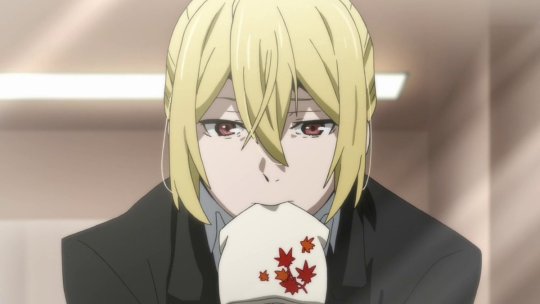
Her composure can often waver. Sometimes she is cool-headed and intimidating, other times easily unsettled and stressed out. Ultimately, she seems to excel more in covert operations than the frontlines, as a tendency to panic leaves her wide open in battle.
Higuchi however has some...strange relationship with the boss however. And this is mostly with what was already established above that the real life Mori Ougai had praised her work which made her very popular. So far in the anime there are three people who Mori Ougai seems close with;
Fukuzawa Yukichi, Yosano Akiko and Natsume Soseki.
Ogai MORI (February 17, 1862 - July 9, 1922) was a novelist, critic, translator, playwright, surgeon of the Imperial Army and Bureaucrat (Senior Official First Class). He was also Army Surgeon General (equivalent to Lieutenant General), Shoshii (Senior Fourth Rank), Order of Merit Second Class, Ko Third Grade, Doctor of Medical Science and had a doctorate in Literature. He is considered one of the great writers of the post-First World War Period ranked alongside Soseki NATSUME. His real name was Rintaro. He was born in Tsuwano Domain, Iwami Province (present Tsuwano-cho, Shimane Prefecture). He graduated from the University of Tokyo, Faculty of Medicine.

Shiyo Ho was born as the third daughter of Soshichi HO (father) and Tsune (mother) who ran a long-established Japanese confectionery shop 'Surugaya' in Kaino-cho, Sakai City (present-day Kaino-cho, Sakai Ward), Osaka Prefecture. One of her real brothers was Hidetaro HO who later became an electrical engineer. Shiyo entered a school of Sinology (the study of the Chinese classics) at the age of nine and also learned koto (a long Japanese zither with thirteen strings) and shamisen (a three-stringed Japanese banjo). After entering Sakai Girl's School (present-day Osaka Prefectural Senyo Senior High School), she devoured the Japanese classics such as "The Tale of Genji." In addition, she said, under her elder brother's influence, 'by the time I was twelve or thirteen, my greatest pleasure was reading literary magazines "Shigaramisoshi" (and later its successor "Mezamashigusa") and "Bungakukai" as well as novels by Koyo OZAKI, Rohan KODA, and Ichiyo HIGUCHI' ("Myojo" May 1906).
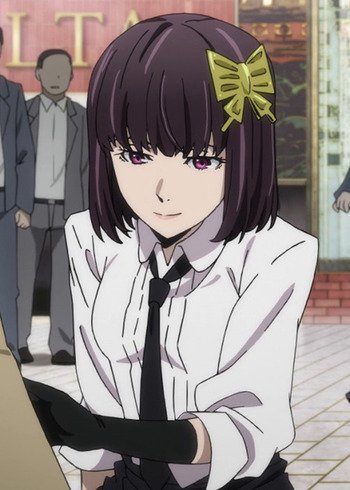
Around the age of twenty she started contributing her poems to magazines while she helped her family business. After participated in the Kansai Young Men's Literary Society, in 1900, she became acquainted with a waka poet Tekkan YOSANO at a poetry reading held at a Japanese-style hotel in Hamaderakoen and contributed her poem to "Myojo," an in-house magazine of Shinshisha (New Poetry Society) founded by Tekkan. In the following year she left her home and moved to Tokyo, and published her first poetry anthology "Midaregami" (Tangled hair) that expressed female sensuality in open fashion with which she established her style as a romantic poet. Later she married Tekkan.
In September 1904, she published a poem "Kimi Shinitamou koto nakare" (Thou Shalt Not Die) in "Myojo." In 1911, she contributed a poem that started with 'Yama no ugoku hi kitaru' (The day comes when a mountain moves) to the first issue of "Seito," the first female literary magazine in Japan. In 1912, Akiko followed Tekkan and moved to Paris, France. Ogai MORI helped her to raise money for going abroad with his wide range of literary works and large circle of contacts, and he also proofread "Shinyaku Genji Monogatari (New Translation of The Tale of Genji)" on behalf of Akiko to which he wrote the preface. On May 5, 1912, the Yomiuri Shimbun started a series of articles entitled 'Atarashii Onna' (New Women) with an article on Akiko's voyage to Paris, and on the following day the newspaper reported her departure (some 500 people including Raicho HIRATSUKA saw her off). The following June issue of the "Chuo koron" magazine ran a feature story on Akiko. On May 19, Akiko arrived in Paris via the Trans-Siberian Railway; during four months up to her leaving to Japan from Marseille, France on September 21, she visited England, Belgium, Germany, Austria, and the Netherlands and so on.
The same like Higuchi Ichiyou, Fukuzawa was praised for his work and put on the Japanese bill. Fukuzawa is respected and is still friends with Mori as evident in season 3 episode 9 where he said after leaving Lucy “I’m going to visit an old friend”.
Despite the many things Fukuzawa witnessed Mori do (which includes mentally abusing Yosano to have her ability of usage for the mafia) Fukuzawa still sees Mori as a friend and that is seen back with how Mori and Fukuzawa fought.
They both went for the more vital points of their body. Making their death quick and painless so that one cannot suffer compared to the other. Even when Pushkin was caught, the two had one brain cell in that moment and both punched the virus ability user.
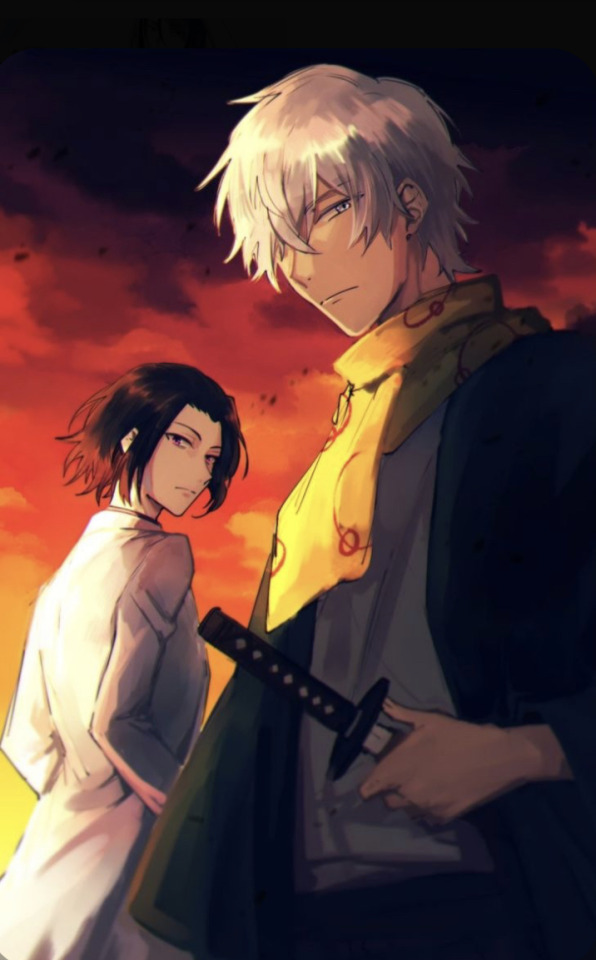
Why are Fukuzawa, Yosano and Natsume relevant you might ask? Well, let’s address the elephant in the room.
Let’s dissect season 1 episode 11 first (chapter 14 in the manga.)
We begin with how Mori Ougai is introduced, which is through Higuchi. After the failure that is capturing Atsushi and selling them for 4 billion yen/dollars Higuchi reports to Mori about their failure. This scene made me, a fan of the irl Mori Ougai’s work, open my eyes and ears to see how the two interact:
Higuchi: “I’m truly sorry for this.”
Mori: “Maybe he’ll never regain consciousness.”
Higuchi: “No way!”
Mori: “Don’t worry. You two have done you’re best. It’s true that you failed in the assault of the armed detective agency, erred during the capture of the man-tiger and sank the freighter along with our cargo. But you’ve done your best, and that’s all that mattered. Making effort is the most important. Results only come second, isn’t that right?”
Higuchi: “....”
Mori: “Oh, yeah. The trafficking company Akutagawa destroyed during the mission...the Remnants of Karma Transit seems to be recruiting. They’re probably planning to take revenge on Akutagawa.”
Higuchi: “what?”
Mori: “Listen, Higuchi-kun. The mafia is essentially an economic body that uses violence as its currency. It doesn’t matter at what got sunk or who got killed but if that violence is returned to us, all our expenses will become liabilities.”
Higuchi: “How could you call those liabilities? They were the fruits of of Akutagawa-senpai’s efforts up until now!”
Mori: “Indeed. Akutagawa-kun is highly capable. His violence is outstanding even in the mafia. **But what about you?** “
Higuchi: “....”
Mori: “Higuchi-kun. Have you ever wondered whether this job is really suited for you?”

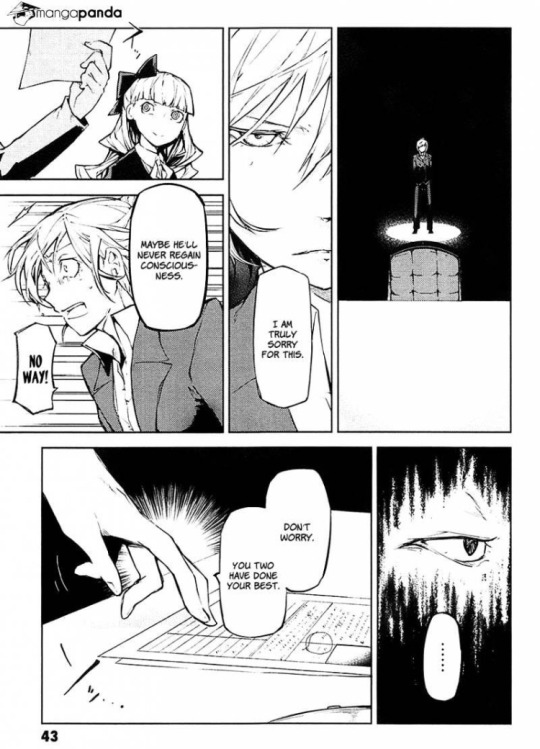
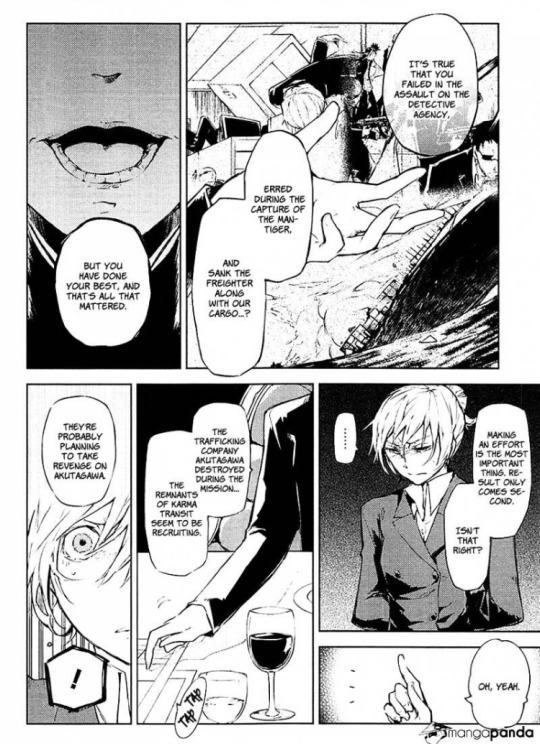
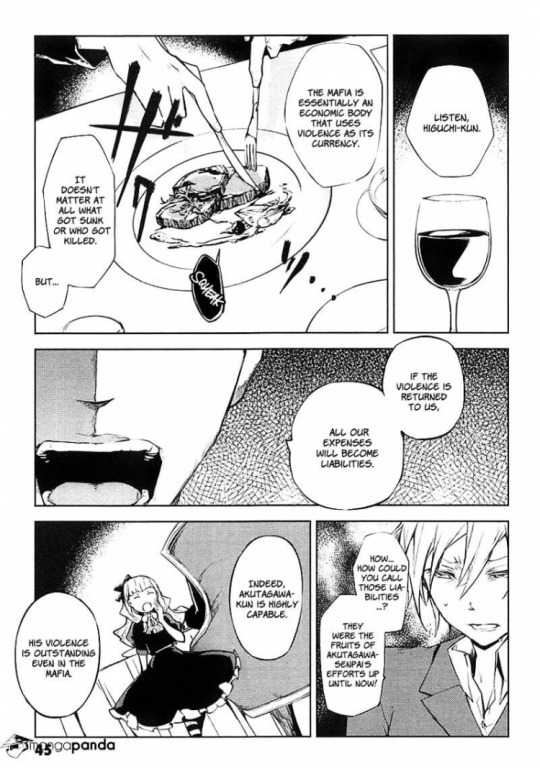
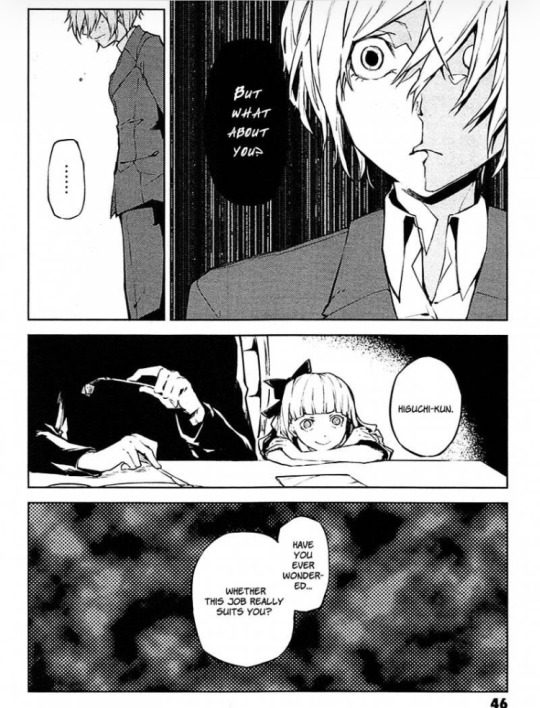
From what we have seen so far, Mori doesn’t seem angry at her actions. In fact, he seems more disappointed but with a hint of worry. Knowing real life mafia bosses, Higuchi would either get fired or tortured for her failures, yet she is here standing without any injuries. This is the most seen in the anime where Higuchi clearly is talking back to Mori, talking back to the king of the underworld.
The next scene is with the Black Lizards.
Tachihara: “This bastard Gin is always put onto sneaky jobs like infiltration and assassinations. Slitting the throats of families and friends on the higher ups order is quite a usual task. If he had meant it, you wouldn’t even have the time to gape.”
Higuchi: “Did the boss say he wanted me dead?”
Hirotsu: “Not yet, but who knows what will happen in the future.”
Higuchi: *cold face* “So you have come here to mock me?”
Hirotsu: “We’re only here to warn you to stay alert. If I were you I would come up with an insurance plan before the hitman starts closing in. The higher ups aren’t the only ones who are after your head. You and Akutagawa are the Guerrilla Squad directly under the boss’ command, giving you the authority to mobilize us in the combat squad, so your technically our superiors. However we don’t obey you out of your authority, but out of fear and respect for Akutagawa’s ability. Higuchi-kun, now that Akutagawa is out of action what power do you posses to make us obey you?”
Throughout the whole entire scene they say that Higuchi, despite her position as their superior, has not much authority over them. The only reason why they follow her is because she is under Mori’s direct order, so she and Akutagawa are second closes to Mori next to the executives.
Yet why is she here if she isn’t that important to the mafia according to the Black Lizards?
In the next page we see that she is against Mori’s order. Higuchi is going against Mori’s orders. This is a giant red flag because she is directly not following Mori’s order; this is enough to get executed under mafia rules yet she isn’t. How? How is she allowed to go through with this?
Let’s look further:
“But the only reason I never actually did it...”
“It’s not easy to break away from the mafia, but it’s not impossible.”
Let’s take the first sentence. She never finished it. She never said the reason why she never left. All we see is her remembering Akutagawa. This could mean one of two things; 1, she is in love with Akutagawa and wants to protect him or 2. She admires him for him using his ability more efficiently compared to her.
You might be asking, how did we go from Akutagawa to Higuchi’s ability? That’s simple.
Let’s remember Tachihara for example. At first we thought he wasn’t an ability user like Gin but it was later on revealed that his ability, Midwinter Memento, allows him to manipulate metal. While it has nothing in common, the name and the ability itself, this can be the same for Hirotsu.
Which means that authors have abilities, and Higuchi Ichiyou isn’t just some author. She is the first ever female author that got so high as being on a yen bill. So her not having an ability is rather suspicious.
Not only that but let’s look at how the novel 55 minutes describes her:
The novel described Akutagawa as an ability user, how would Higuchi not be described as a non-ability user? Because she is an ability user.
Which brings us back to the first take. Many mafioso’s would get in trouble for going against Mori’s word. With Higuchi it is differently; in season 1 episode 11 you see that Higuchi was talking to Mori on a rather even note, her eyes shined a few times which means that she appreciates the praises but she still went against his word by saying “Akutagawa has done so much to be considered a liability.” She talked back against the boss, that would be considered a punishment in the underground yet Mori kept her. This is also shown in the manga where in the mall, Higuchi talked once again back against him but Mori warned her as if she was a child that wants to know more about her birthday present.
Compare this to how he talks to Hirotsu; a mafioso who is longer in the mafia compared to Mori.
He talked back to him and he got a glare and was questioned “what do you want to say?” In a threatening type of way. Knowing Mori, it isn’t because of the former boss because Mori doesn’t care about him anymore nor is it about Dazai taking his place, that is his main goal.
My theory is that Higuchi’s ability is that big of a liability that she is Mori’s secret weapon.
In season 1 episode 11 she keeps saying “it is difficult to leave the mafia but the reason I stayed is because...”
She never finished her sentence. She never told the full reason why she stayed. In the manga we are shown that she isn’t respected, that subordinates walk over her. Yet even with these facts, Higuchi isn’t fired.
She also says “it is difficult to leave the mafia but it isn’t impossible”
That is a lie because as we have seen with Kyōuka it is impossible. How does Higuchi have such privilege? Because Mori knows she will come back. The reason why in her monologue it showed Akutagawa is because she admires him for being able to control Rashoumon, the same way how Atsushi finds Akutagawa amazing for being able to control Rashoumon.
Mori favors her, and this is shown in a panel in Wan where Higuchi does an impression of Mori when he is with Elise yet instead of being angry at Higuchi, Mori directs his glare to Chuuya and Tachihara. There is also a chapter where Tachihara, Higuchi, Akutagawa and Gin destroyed the Black Lizard hideout but instead of punishing Higuchi (who was the source of the accident) he punished them all.
Let’s look at another thing; how close is Higuchi with Mori?
Season 2 episode 8 where Mori was stabbed by Fyodor. It was brief but we see Higuchi together with the boss. Out of everyone in the mafia; Kouyou, Chuuya, Kajii hell even Akutagawa could (but he was busy looking for Nathanial) it was the least respected mafioso. Not only that but Higuchi back in season 2 gave information that the boss gave personally to Higuchi to send to Dazai.
This could have also been done by Hirotsu or Gin who know Dazai the longest. But something caught my attention. Higuchi said “I researched your history.” This wouldn’t seem bad was it not that Mori keeps Dazai’s executive position open for him to return, so Dazai is still technically an executive. ONLY EXECUTIVES are allowed to learn the history of the other executives. Gin, Hirotsu, Akutagawa, Kajii, Chuuya and Kouyou know about Dazai because they have an actual history with him but Higuchi is an outsider of this. She is like the other mafioso who aren’t related to Dazai yet she did research on him, which isn’t allowed.
Now this might sound as if Higuchi is special but let’s look at something or more someone who also didn’t look special but actually is special; Tachihara Michizo.
On the surface, Tachihara is an arrogant, impulsive, rash individual, more than willing to solve problems through sheer brute force and his dual guns. A violent temper leads to frequent conflict between him and other mafiosi, namely Gin, whom Tachihara views as creepy and frequently insults, leading to arguments, and Hirotsu, who often shuts Tachihara's temper down by threatening him. Tachihara's self-preservation prompts him to obey Hirotsu in the end, albeit reluctantly. An apparent thirst for battle and arrogance fuels Tachihara's temper. He's often seen with a rather feral smile on his face whenever fighting. He seldom considers the weight of a mission over the rush of eliminating his targets. He shows no hesitation nor remorse in murder, in fact sometimes urging to just eliminate a troublesome person if he finds their baggage more than they're worth.
A prideful man, Tachihara despises being underestimated and belittled. This is a surefire way to get oneself shot.
His rebellious side doesn't negate how he values orders, seeing them as an utmost system. Due to this, he attempts to dissuade Higuchi from saving Akutagawa against Mori's orders, even suggesting an alternate plan that wouldn't disobey these orders. Furthermore, he maintains his composure when dragged into shopping with Elise, and tolerates her putting bows in his hair. Despite guards laughing at him, Tachihara doesn't snap. Despite his rough exterior, Tachihara is capable of thinking rationally, just not in the heat of the moment in the Port Mafia. He can recognize danger quickly and finds himself on edge over how nonchalant Mori, Kōyō, and Chūya's meeting went. Tachihara has a proficient understanding of how to deal with the enemy, alluding to a much more cunning side of his true nature.
Much of Tachihara's details of joining the Port Mafia are unknown, however, it is a ruse. His identity as the fifth Hunting Dog reveals a much more clever, driven man. Unlike Ango Sakaguchi, Tachihara always intended to infiltrate the Port Mafia, using his position in the Hunting Dogs to operate as a spy. His confrontation with Yosano is devoid of any rage, depicting a cold, blunt side as he explains his grudge against her for "killing" his brother. Regardless of who he is working for, Tachihara cares deeply for his comrades. He was first to try to stop Higuchi when she tried to save Akutagawa on her own and has been seen visibly harboring guilt for when he cut down Hirotsu and Gin for the sake of his mission as a spy. He has also been seen caring for Teruko when she showed she was heavily injured from going against a plane head-on. He's also notably patient with those who are spoiled, including letting Teruko sit on her shoulders with little protests of being her "slave" and letting Elise put a bow on his head.
Beneath a lot of Tachihara's rough and punk-like exterior is a strong sense of incompetency and inferiority compared to his elder brother who was praised as being "perfect" while he was deemed by his family as being inferior, even being questioned as to why he didn't die instead of him. These things have driven Tachihara to act out and live a life of delinquency and ruthlessness by affiliating with gang activity, but despite these things, he still couldn't shake off these negative feelings. His insecurity and desperation to escape his brother's shadow was so strong, that Tachihara took on the first "order" that allowed him to become someone "not like his brother or his opposite" and joined the Hunting Dogs and infiltrate the Mafia to get revenge on Yosano for "killing" his brother, even when he knew and acknowledged that all of it was an excuse to appease his own negative feelings.
Many didn’t think much of Tachihara next that he was a commander of the Black Lizards and just someone who is close with Chuuya in Wan, however in the current arc we learn that he is a member of the Hunting Dogs with his ability Midwinter Memento being perfect for to lure Yosano to him, and in his fight with Fukuchi we learn that Mori giving him the order to kill Fukuchi was perfect for him.
Tachihara’s ability is named after his famous poem;
*Neither pursuing nor being pursued,
I stand under a barren tree. I'm watching
my silhouette, now marooned on a spotless snow....
(My pale shadow somberly takes shape.)
I'm listening. Yes! I certainly
am listening to what my shadow sings....
In a plaintively nasal voice it sings tunes of long-gone
summer flowers never to return.
Without responding, "That's a bunting, that's a siskin,
that's a white fir
—that's me...I a siskin, I a fir...," my shadow and I
eye each other as though these statements once were true.
My shadow listens to my heart at song.
Like the hubbub of that old arrowing brook,
it listens to tears at song...on the snow.*
This poem is seen mostly how Tachihara lives in the shadow of his brother, how much he listens to what others have to say because he himself can’t find a reason to do something.
As we already had established, Higuchi Ichiyou is a famous female writer. And the characters based on the authors and their books have an ability.
However there are two (three) categories: Name based abilities and non-name based abilities.
(Three being a non-abilities)
Non-abilities: The Great Old Ones and Ultra-Deduction.
Name based: Beast Beneath The Moonlight, Doppo Poet, All Men Are Equal, Lemon Bomb, The Great Fitzgerald, Thou Shalt Not Die, Gone With The Wind, I Am A Cat, A Feast in Time of Plague, Anne of Abyssal Red, Moby Dick, Time Machine, Yesterday’s Shadow Tag, The Grapes of Wrath etc.
Non-name based abilities: Vita Sexualis, Midwinter Memento, Another, An Inherent Drop, Black Cat in the Rue Morgue, Little Woman, Demon Snow/Golden Demon, Flawless, Futon, Plum Blossom in Snow, Priceless Tears, Undefeated By the Rain, No Longer Human, For The Tainted Sorrow etc.
Higuchi Ichiyou’s famous short story Takekurabe (Growing Pains) could be her ability based on that Mori Ougai had praised her for it, which eventually became they key to her success;
“ * [Higuchi Ichiyō’s] ‘Growing Pains’ was acclaimed as a masterpiece, especially when the entire work was republished in a single issue of the popular magazine Bungei Kurabu in April 1896, Mori Ōgai… lavishly praised its every feature: … (Ōgai): It is not especially remarkable that this author, a member of a literary circle in which the Naturalist school is said to be enjoying a vogue should have chosen to set her story in this place [the Yoshiwara district]. What is remarkable is that the characters who haunt this area are not the brute beasts in human form - the copies of Zola, Ibsen, and the rest - presented by the assiduous imitators of the so-called Naturalist school, but human beings with whom we can laugh and cry together… . At the risk of being mocked as an Ichiyō-idolater, I do not hesitate to accord to her the name of ‘poet.’ It is more difficult to depict a person with individual characteristics than a stereotype, and far more difficult to depict and individual in a milieu than a special person all by himself. This author, who has painted the ‘local coloring’ of Daionji-mae so effectively that one might say it has ceased to exist apart from ‘Growing Pains,’ without leaving any trace of the efforts such portraiture must have cost her, must truly be called a woman of rare ability.* “
(Credit to Donald Keene, Dawn to the West.)
But what could Growing Pains do if it was actually an ability? For most we need to understand what an actual ability needs to have in common.
For this we will take For The Tainted Sorrow and see how this ability is related to gravity?
With literal names based abilities we look at Atsushu. Atsushi has the ability to transform into a white tiger. At first, he doesn't seem to have much control over the transformation, likely due to the fact, or caused by, his unawareness of his state as an Ability user. After becoming an official member of the Agency and under the influence of All Men Are Equal, he gains more control over his transformations - as shown during his second fight with Akutagawa, when he breaks the transformation on his arms to escape.
My theory is that Higuchi’s ability allows her to paralyze her enemies.
Let’s look as too why I think this and use the summary of Takekurabe as an example; The main characters are children living on the edge of Yoshiwara, the only district of Edo that was licensed for prostitution. As they grow up, they find themselves assuming their family professions and losing the freedom they enjoyed as children. Next we have Nigorie translated into English as Troubled Waters and Muddy Water, is a Japanese short story written by Higuchi Ichiyō in 1895. It depicts the fate of a courtesan in the red light district of a nameless town during the Meiji era. Nigorie centers around Oriki, the most popular courtesan at the Kikunoi, a brothel in the red light district of an unspecified town, and a group of people connected to her, during the summer Obon festival. Through her conversations with other prostitutes, and Oriki's accounts in the presence of new customer Yūki Tomonosuke, the reader learns that a previous customer, Genshichi, a futon salesman of moderate affluence, was addicted to Oriki and spent all his money at the brothel. Now that Genshichi has been reduced to the hard labor of a construction worker, forced to move with his wife Ohatsu and his young son Takichi into a smaller flat in a run-down section of town, Oriki rejects seeing him despite his pleas. Tomonosuke repeatedly questions Oriki during his visits. She reminisces about her poor upbringing, which she cites, together with her profession, as the reason for not wanting to marry, although she had contemplated the possibility. She recounts a childhood incident when she was seven years old, sent by her mother to buy rice for supper. On her way back, she slipped on the frozen ground, spilling the rice into the gutter, leaving the family starving for this day. Meanwhile, Ohatsu scolds Genshichi for his ongoing obsession with Oriki and the family's poverty, which she tries to mitigate by doing piecework. When Takichi comes home with a piece of cake, which he received as a gift from Oriki (whom he refers to as "the demon-lady"), Ohatsu angrily throws it away. Genshichi, furious about her ongoing accusations and behaviour, demands that she leaves him. Ohatsu begs him to let her stay, as she has no relatives she can return to, but finally leaves, taking their son with her. At the end of the festivities, the dead bodies of Oriki and Genshichi are found. While it seems obvious that Genshichi committed suicide by seppuku, the cause of Oriki's death stays unclear. The passerbys speculate about her fate; while one assumes a shinjū (double love suicide), another one reasons that the wounds on Oriki's body make a murder after her attempted escape more plausible. It is left to the reader to determine the true circumstance of her death.
From these famous stories we can already determine that Higuchi’s stories are centered around the concept of one-sided attraction. This is something she and Akutagawa have, a one-sided attraction. This is the most in season 3 episode 5 where Higuchi doesn’t seem to find her way of trying to confess that she loves Akutagawa or that she thinks she admires him. And what is there not to admire about Akutagawa? He has an amazing ability, he is reliable in many ways but is just stubborn. So with this in mind, Higuchi’s (if this theory is correct) ability comes in this form; Higuchi’s ability is a mix of a non-name based ability and a name-based ability. The ability of paralyzation has the meaning of that she is paralyzed by fear with job as a mafioso but also her fear of being rejected by Akutagawa and that it is the greatest liability Mori has in order to protect Yokohama-This idea comes more in mind in the manga, Chapter 41, where we briefly see Higuchi’s little sister. This may not mean much to you but Higuchi is the only confirmed character with a little sister who isn’t based on a book (Gin=Ogin and Naomi=Naomi). Which leads me to the reason why she doesn’t use her ability anymore or is restricting herself- and the second is the meaning of Growing Pains ; Growing pains are often described as an ache or throb in the legs — often in the front of the thighs, the calves or behind the knees. Growing pains tend to affect both legs and occur at night, and may even wake a child from sleep. Although these pains are called growing pains, there's no evidence that growth hurts.
There could have been an incident in which Higuchi accidentally used her ability on her little sister which resulted in her little sister being paralyzed. She could have met Mori and knowing Mori he manipulated in keeping her ability a secret and for repayment let her join the mafia. This idea is further proven with how he was with Yosano; after the death of Tachihara’s brother Mori manipulated Yosano into thinking that this is her fault, almost making her join the mafia out of guilt was it not for Ranpo.
6. Maybe Higuchi wasn’t as lucky and thought that what Morti said was true and joined the mafia out of guilt, which leads me as to why she fell in love with him. The nightingale effect; The Florence Nightingale effect is a trope where a caregiver falls in love with their patient, even if very little communication or contact takes place outside of basic care. Feelings may fade once the patient is no longer in need of care. Higuchi fell in love with Akutagawa not out of admiration but out of care for him. That guilt of not being able to take care of him could be because of her little sister and the fear that Higuchi one day paralyzes Akutagawa, as to why she isn’t using her ability. After all, this isn’t the first time there was a character who hid their ability to do things without it; Fyodor and Tachihara.
And the last thing that might confirm Higuchi’s importance is the way she acted in Wan and the Onsen drama CD. While Wan is merely a comedy it does call out the characters for their flaws and unique personalities, meanwhile the Onsen drama CD is like a filler but adds information about certain characters and their relationship; Higuchi included.
1. She stalks Akutagawa at first out of fear that other organizations might attack him, but at this point she stalks him with a mix of worry and not being capable of walking up to him.
2. She is rather open to nudity as shown that she said to Chuuya “it is my job to help Akutagawa even it means being naked” (or something along those lines).
In a certain chapter however where the Port Mafia had to disguise themselves as Mori, Higuchi was up and while she failed to look like Mori because she is very feminine she then used another tactic which is acting like Mori when he is with Elise. For most, Mori would have either glared at them and give them punishment, he glared at Chuuya and Tachihara (who were the closest next to him) instead at Higuchi. Higuchi broke many Port Mafia rules, many times she failed and has unintentionally mocked him yet she is still here.
so what do you guys think? Is this theory plausible?
#higuchi ichiyo#higuchi bsd#theories#speculation#bungou stray dogs#mori ougai#yosano akiko#tachihara michizou#ability
89 notes
·
View notes
Note
3, 4, 7, 19, 20! if that's too much then any of those are fine lol
Thanks for the asks!!
3. What is that one scene that you’ve always wanted to write but can’t be arsed to write all of the set-up and context it would need? (consider this permission to write it and/or share it anyway)
I have a couple of canon-divergence fic ideas that would require, not so much setup as ... a lot of research into canon and re-reading? This is probably obvious but I have but the faintest grasp of Naruto canon beyond the stuff my faves did. Often I'll be talking to someone and they'll bring up some point of Lore (TM) and I'm like "Oh, I genuinely never knew that." Like I don't know shit about dick about Konoha's founding, because I straight up didn't care and didn't read/watch a bunch of canon.
Anyway, one of the ideas that I've had on my ideas list for a long time is a fic where the chuunin exams go quite differently and basically neither Gaara or Lee are able to continue on as ninjas. Lee because he never attempts the surgery and Gaara because he sustains internal injuries that heal imprecisely due to the nature of Shukaku's healing factor and basically physically limit him beyond the point where he can function as a shinobi (I sort of played around with this idea a bit in 'A Personal Dictionary of Obscure Sorrows' but this case is a bit more fleshed out and plot-essential). Basically the concept is that while jinchuuriki have a healing factor, the Beast chakra doesn't 'care' that much about anything other than having a functional vessel, so it sort of patches all of his organs from where Lee beat his ass (and where he throws himself out of the hospital window) but without much thought to adequate healing beyond 'he needs to stay alive'. And then the Council gets involved and tries to extract Shukaku and place him in someone else and ~additional plot stuff I would need to reread the manga to figure out~.
The scene that I actually want to write from this is the one where Gaara and Lee reunite after having been on these very divergent paths for years but still having corresponded by letters, and Gaara hasn't really reformed or gotten over his feral nature, and he's living out in basically a hut in the desert, and then he eats a live lizard in front of Lee's horrified face but Lee falls in love with him anyway.
4. Share a sentence or paragraph from your writing that you’re really proud of (explain why, if you like)
Haaaahaha, I've gotten this question several times in this meme and I genuinely never know what to point to? I forget a lot of things as soon as I've written them. So it's less what writing am I proud of, and more what writing did I really enjoy doing?
One thing I did have a lot of fun with recently was coming up with everyone's dragon mounts in 'Dragonhearted', so here's a little snippet from that, about Team 8:
The square-headed one with the long, furry tail gamboling out front had to be Akamaru, with Kiba riding atop. Kiba’s family had been dragon tamers since before there was even a word for it. The first woman to raise her hand to a dragon’s snout, bond with it, and bring it to heel was said to be an Inuzuka matriarch. Lee could believe it; Inuzuka women were even more ferocious than their mounts.
Behind them came a creature with two flat-faced, whiskered heads on snaking necks, a single rider straddling the broad back. Hinata must have left Neji at home—he hated getting up early in the morning—and commandeered Shisa and Komainu for herself. Their twin mounts were elegant in the style of all Hyuuga mounts, but terribly impetuous. Even now the two heads were snapping at one another mid-air, snarling.
And finally came the clicking and snapping of hundreds of sets of wings, shiny black and translucent; and the snorting of air through snouts that looked like the forks of a rhinoceros beetle’s proboscis. The dangling feet borne aloft by the swarm of tiny dragons could be no one other than Shino. His mounts couldn’t even be properly called mounts—none of them was large enough to carry a human on their own—but they worked like a hive of insects with just one mind to keep him aloft.
7. What do you think are the characteristics of your personal writing style? Would others agree?
I genuinely don't know if others would agree, but I think my stuff tends to be quite plot-light and quite emotion-heavy. I like a lot of physical descriptions and a little bit of purple prose. I tend to lean on the little details of people - microexpressions, the motions of hair, what their fingers and eyes are doing. I don't think I'm especially strong at developing a plot with actual beats and following it to a conclusion; even stories that have some 'adventure' to them tend to be less about the Things the characters are doing and more about Who they're doing it with. There's a lot of times I feel I've set something up and don't have the chops to pay it off, or that I simply don't want to write a climactic battle or bit of ninja intrigue because what I'm really here for is the relationships. I hate writing fight scenes, and I'm not really intelligent enough to do the political machinations and inference stuff that Naruto as a canon relies on, so there's a lot of times where I write 'the characters go on a mission but nothing very important happens, because I want them to smooch'. I lean heavily on dialogue as a hook, but I don't actually have the characters speak much or say much of consequence; much of what's 'happening' is internal narration, memory, and scene description.
19. Is there something you always find yourself repeating in your writing? (favourite verb, something you describe ‘too often’, trope you can’t get enough of?
Answered here!
20. Tell us the meta about your writing that you really want to ramble to people about (symbolism you’ve included, character or relationship development that you love, hidden references, callbacks or clues for future scenes?)
This is more trivia than anything, but Lee's genin team in Chapter 6 of 'On My Way Home' are named after some of my favorite Japanese sportclimbers: Tomoa Narasaki, Akiyo Noguchi, and Miho Nonaka. Ai Mori is actually my top fave but it's beyond cliche to have an anime OC named 'Ai', so unfortunately she got left out. I think I've talked about this a bit before, but I'm like really into semi-obscure sports, and I love watching climbing competitions.
Fun Meta Asks for Writers
6 notes
·
View notes
Text
March 14, 2021: The Holy Mountain (1973) (Part One)
Happy Pi Day! What’s on the menu?

...Oh dear Christ. Looks like it’s a cloud pie, because this one’s gonna be OVER my head. And yes, I realize that it’s Pi Day after the irrational number, not the food. Which is ALSO fitting because I’m sure we’ve got a fuckton of irrationality coming my way, and I am...not ready? Yeah, yeah, I’m not ready.
But OK. Who actually made this movie? Alejandro Jodorowsky? Oh.
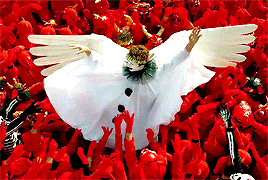
OH. This...I should’ve put this in goddamn Experimental June, huh? Well, shit. I ean, it fits in with the patter of films I’ve been watching recently. You know, Greek mythology, Japanese folklore, then a surrealist film released by a notable director? And Jodorowsky is notable...in film circles, anyway. He’s not exactly a household name, but he is very well-known regardless.
Alejandro Jodorowsky is a Chilean-French man best known for his Mexican films. So, yeah, already interesting there. His Wikipedia article describes him as such, right off the BAT.
Since 1948, Jodorowsky has worked as a novelist, screenwriter, a poet, a playwright, an essayist, a film and theater director and producer, an actor, a film editor, a comics writer, a musician and composer, a philosopher, a puppeteer, a mime, a lay psychologist, a draughtsman, a painter, a sculptor, and a spiritual guru.
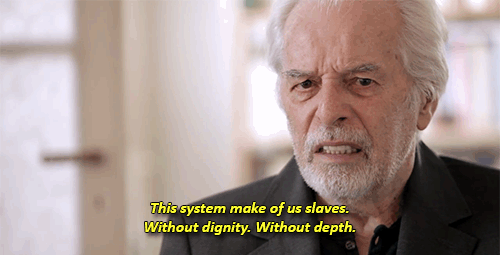
Dude had a movie made ABOUT HIM TRYING TO MAKE A MOVIE. That would be Jodorowsky’s Dune, a documentary film about Jodorowsky’s attempt to make an adaptation of the book Dune, well before the actual first film came out. And people LOVED that film. The film about a filmmaker making a film...I am frightened.

And I’m not going to spoil it for you, but in looking for the GIFs of this movie...guys, I am FUCKED. I’m a boring-ass man, in that I’ve never so much as smoked a cigarette, and I have the feeling that I’m gonna feel high watching this movie. I am NOT ready. But OK, with that, let’s just get into it, huh? Let’s get this trip over with. SPOILERS AHEAD!!!
Recap (1/2)

Two women are staring at me. And so is a dude dressed all in black with a crazy hat, as chanting goes on in the background in a white room with black crosses on the walls, and we’re JUST JUMPING RIGHT THE FUCK IN, HUH?
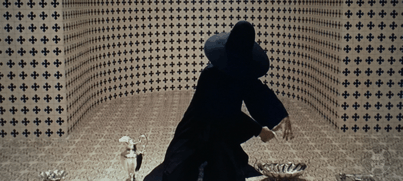
The title comes up, dude just rips their clothes off, and YES THERE IS A GIF OF IT ON TUMBLR ALREADY, and I’m probably gonna flagged for that, BUT WHATEVER
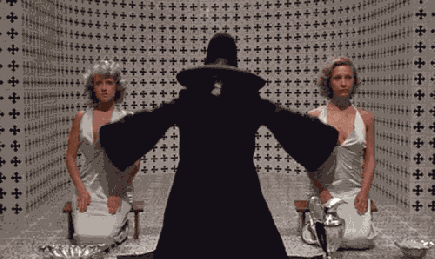
He shaves their heads, they enter a warm embrace of sorts, AND THEN WE MOVE ON TO A POINTED EYEBALL SURROUNDED BY PEACOCK FEATHERS I AM COMPLETELY LOST
Well, actually, as the credits play, backed by a sound which I can only assume is the creaking of the opening gates of hell, there are a number of objects and artifacts, with peacock feathers seeming to be a common theme. And then...a man with the tarot card The Fool next to him pisses himself in the desert as flies cover his face, a cougar standing over him and roars, a bullfrog looks at some tarot cards, and a legless and handless man with the Five of Swords card strapped to his back comes to wake him up with the aid of several naked children, who tie him to a fake cross and throw stones at him.
ALL OF THIS HAPPENS IN ONE MINUTE, AND I DIDN’T EVEN MENTION THE FLOWER GROWING STABBED INTO HIS PALM

Somehow...I underestimated this movie. I DIDN’T THINK IT’D BE THIS CRAZY THIS QUICKLY. Well, after...THAT, the two men share a cigarette and hug as the Swords guy licks his forehead, and they walk into the city. There, we see some grizzly ass shit. There’s a truck carrying the bodies of killed native people, a firing squad shoots some kids who...bleed black, and a fuck-ton of sheep who’ve been skinned and fake-crucified are marched down the street as a bunch of rich people watch on. Also, another firing squad shoots at some kids, and birds fly out of them.
I think the people watching are tourists, and this...might be fake? One of the fake soldiers takes one of the tourists aside, and just...starts fuckin’ ‘er. In front of her husband, as people take pictures of the whole thing. I...I am more confused than I have EVER been.

By the way, I don’t know ANY names for this yet, so I’ll add them...whenever I figure it out. Our pair apparently entertain these tourists, and make money doing so. They work with a circus called “The Great Toad and Chameleon Circus”, who perform a pantomime of the conquest of Mexico, using...costumed toads and horned lizard. And it’s...I mean, it’s definitely bad for those animals, but it’s also kind of adorable?
The horned lizards represent the Aztec, while the toads represent the Spanish. And, uh...yeah, it’s literally exactly what I said. The Spanish toads go after the Aztec horned toads, and overwhelm the fake Tenochtitlan with their sheer numbers. What’s weird about that? WHAT IS SO WEIRD ABOUT THAT TO YOU?

There’s also a lot of...what I’m assuming to be fake blood, but with this movie, I worry. The whole dead sheep thing has me concerned AND THEN THEY BLOW UP THE SET AND KILL THEM ALL WHAT THE FUCK MAN? How did this film escape animal cruelty shit?
And then...look, you’re gonna have to get used to weird-ass shit happening here, OK? And for the record, I’m desperately trying to weave some symbolism out of things here. Like, this is clearly a criticism of tourism and wealthy cultures taking advantage of the disadvantages. It also seems to be anti-religious, although...I’m not sure if I can articulate that one yet. Still, this part of the film seems to be about the disadvantaged native people being used as essentially objects by the rich foreigners. I mean, they just used the Spanish Conquest of Mexico, for God’s sakes. It’s a new form of conquest, but modernized.
Right? OK, OK, maybe I can do this after all. What’s next?

A bunch of overweight dudes dressed up as Roman soldiers, alongside a guy dressed as a nun, are selling crosses and Catholic materials to the tourists, while the Fool and Swords pretend to be Jesus Christ for them. This eventually leads to them goading the Fool into a drunken stupor, then making a plaster mold of him before leaving him on a pile of potatoes. Eventually, he wakes up and screams, surrounded by hundreds of casts of him painted as Jesus Christ, as the Roman soldiers and the nun dude sleep.
Angered at his own commercialization, Fool whips the nun and soldiers, and destroys all of the Jesus statues. Meanwhile, a group of women - of different races and ages - and a chimpanzee stare at a gilded statue of Jesus in a church.
Sure. Why not? WHY NOT?

Also, they’re prostitutes, and one of them is, like, a child. Fuck. Said child is approached by an elderly man, who giver her his fake eye, than proceeds to kiss her hand...A LOT. OK, I know there’s something to be gleaned from that. Said prostitutes meet the Fool, who’s carrying the Jesus cast. Most of the laugh at him, except for the one carrying the chimpanzee, which I’m assuming is a Mary Magdalene reference.
She follows him, and the other prostitutes follow her, but they all stop when they come across a group of civilians dancing with soldiers. The Fool walks through this crows alone, and ends up in a dilapidated church, where he finds an owl and a priest, who’s sleeping with another Jesus statue. Angry that the Fool’s brought in his own statue, he kicks him out. The Fool then eats the face of his statue, then takes it back to the children from earlier, ties a bunch of balloons to it, and lets it fly above the city, the kids, and the prostitutes.
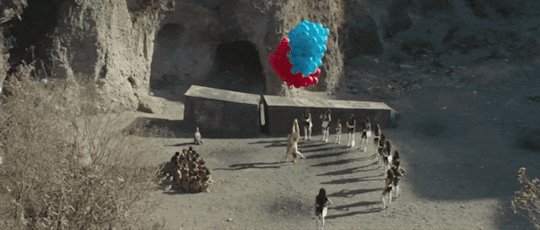
I, uh...I don’t know. I DO NOT KNOW.
From there, the Fool goes into town, there a red tower stands in the square. Maui’s hook descends from the top, and the Fool climbs onto it. The hook takes him up, as “Mary Magdalene” watches on. And it goes up VERY HIGH, by the way. GODDAMN. He gets into a hole at the top of the tower, where he finds a white shroud, which he bursts through, only to find...

I’m so tired. I am SO TIRED, you guys. Our guy heads down the rainbow toward the camel, the naked woman, and the man surrounded by two goats, who I think is the guy from the beginning. He’s wearing the same hat, anyway.

He slowly and measuredly moves off his throne, as the music in the background intensifies, and as the camel is fidgeting, seemingly ALSO trying to figure out what the fuck is going on. The man gets into a brief fight with the Fool, but stops him by touching his chakras. With the help of the woman, he slices open a tumor on the back of the Fool’s neck, and extracts an octopus from it. Yeah. YEAH. WHAT THE FUCK IS THIS MOVIE

The man offers him gold, in the FIRST UNDERSTANDABLE SPOKEN WORDS IN THE MOVIE I AM NOT KIDDING

They take the man to a pool, complete with baby hippo (what, do you not have your hippo in your personal pool, like a goddamn loser?), and the man gets cleaned, VERY thoroughly. Yeah, we see it.
In another room, with a pelican in it this time, the man has the Fool defecate in a jar, and also puts him in a container, where he sweats a lot. The guy collects his sweat in a hear-shaped jar, and continues his chemical reaction with the dude’s feces. It’s at this point where I think it’s appropriate to give the name of the man in the tower: The Alchemist (Alejandro Jodorowsky). Yeah. It’s the director. Take THAT, Hitchcock.

After literally turning his shit into gold, the Alchemist says that the Fool can do the same to himself, as he is shit. Yeah, he says that. And then, the two meet in a room of mirrors, where the Alchemist is now wearing a black outfit, and the Fool is wearing a matching brown one. They break a stone, in which we are told that each stone has a soul.
And then...tarot.
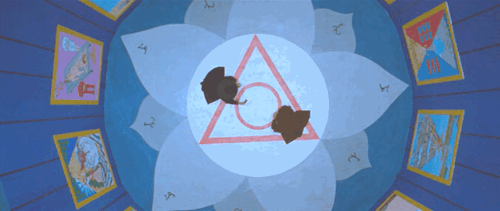
Yeah, that seems to be a theme, huh? According to the Alchemist, Tarot will teach the Fool to create a soul. I get the feeling that it’s meant to be within himself, but...I don’t know. Also, the tarot cars that we see are definitely supposed to represent previous scenes in the film, some of which we’ve already seen. However...they’re still pretty goddamn weird.
He gives him a few items, then brings in an ox and a turkey vulture. Goddamn, dude owns a zoo, huh? He uses the two to speak on the cyclical nature of life and death, and how organisms depend upon each other. This leads to yet another room, with a peacock in it this time, where he notes that the fish never seeks the fisherman, meaning that the master seeks a disciple.
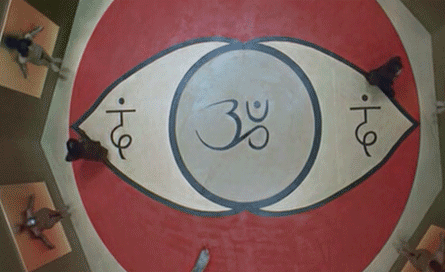
In this final room, there are statues of people who are like him, and who will be needed for the coming journey, whatever that may be. They are industrialists and politicians, and each represents a planet...and maybe something else. They are, in order:
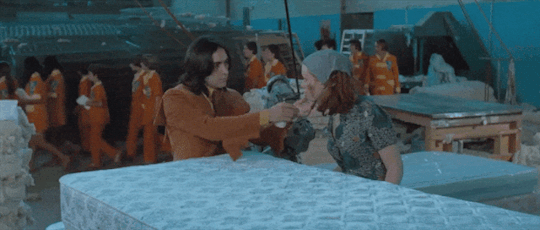
Fon (Juan Ferrara): Our Venus, and a bedding and clothing business magnate. He has many wives, who begin as workers in his factory, then are promoted to his “secretaries. He also has a fuckton of children as a result. His father began the factory, and is deaf, dumb, and blind. He makes all decisions by consulting his wife’s corpse’s vagina. Yup. Dear Lord. The company’s also made masks that have the texture, warmth, and smell of living human beings, allowing anybody to change their face to something more desirable. They also beautify corpses, and animates them after death. Fuck.

Isla (Adriana Page): Our Mars, Isla is first seen in a coffin-like bed, sleeping with the two bald women from earlier. After putting on her Prince suit, she wakes up her captive population of male secretaries, and her flock of black swans, and goes to her day job: manufacture and sale of weapons. We’re talking nuclear, biological, and fictional. They experiment with drugs that have various effects, and demonstrates them on many people, and make such unique things as psychadelic guns and grenades, and themed weapons for the religious crowds.

Klen (Burt Kleiner): Klen’s our Jupiter, and his house is huge, his wife is cold and unloving, and his chaffeur feeds him coke in the back of his black limo. He has a mistress that he fucks in the back of the limo, on the way to his art factory, where they produce a “new line” of art every season, using girls’ asses, and various other parts of bodies. He LITERALLY objectifies people. He also created a “love machine”, which is literally a robot box with a robot vagina that you fuck with a giant blue artificial penis. It is a...weird but interesting scene.

Sel (Valerie Jodorowsky): Sel’s a clown, who represents Saturn, and performs for children. Which makes sense, seeing that she’s a clown. She has a toy factory as well, where she sheds her harlequinesque vestments for a far harsher, stricter persona. Her toy factory is for war toys, and all of the staff and workers are elderly. Using a computer, they use their resources specifically to corrupt the minds of children to feed their political agendas, conditioning them to hate whichever enemy the government will face in the future, literally sowing prejudice and racism into their minds in preparation for a future war. Eerie.

Berg (Nicky Nichols): Uranus next! And Uranus is...EXTREMELY weird. Like, you know how you shouldn’t kink-shame people? That does not apply to Berg, both because he probably SHOULD be kink-shamed, and also because I don’t think it’s possible for him to feel shame? This entire section begins...real weird. Berg and his wife (Lupita Peruyero) are a very eclectic and unusual couple, but they aren’t as bad as the rest...I think? I mean, she’s literally knitting a sweater for their giant pet snake, and it’s kind of adorable. And then...we discover that Berg is a financial adviser to the president of a very wealthy country. He recommends that, in order to save the economy of the country, they kill 4 million people. THe president then activates the country’s gas chambers, gas schools, gas universities, gas libraries, gas museums, gas dance halls, and gas whore houses. Not a joke, that is actually what he says. And that’s...kind of hilarious? That segment ends with a picnic, and Berg says he hates his wife while surrounded by many very beefy bois. OK. My favorite so far, and that’s not even an exaggeration.

Axon (Richard Rutowsky): Besides having a HELL of a name, Axon’s the Neptune of this Solar System. He’s a chief of police. Which involves...a naked man chained to a table as many people chant and play drums. And then, Axon comes in with a GIGANT GUN, while bedecked in clothes made and worn by the forbidden love child of Mad Max and Roman soldiers. The ceremony is actually a castration, and it’s Axon’s 1000th castration. Axon commands many eunuchs, all of whom are trained to believe in him. It’s very...cultish. And that’s made worse when a group of protestors are attacked by Axon’s police force. They execute them, with the murder represented by interesting symbolism. Like, instead of blood and guts, it’s fruit and birds, and...also the thing above, which is funny only out of context. It’s also eerie.

Finally, Lut (Luis Lomeli): Lut is an architect, and our Pluto. In his house, there is a bevy of children dressed up as mice, who are playing hide-and-seek with him. Lut built a multi-family complex, but begrudges that they lost money in doing so. And so, to save money, he decides on a new concept for homes: basically just a box that people sleep in. Nothing else. He presents this at a party, where he unveils the house, which is essentially a coffin. He uses a sex show and women to sell it to the overindulgent rich. There’s also a well-sculpted ice penis involved, which must have been an interesting job to get for the guy who made that. Anyway, yeah, he’s trying to turn homes into coffins.
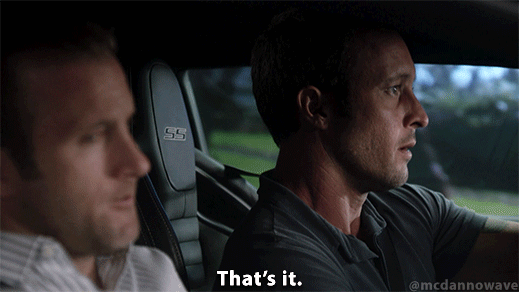
Jesus. That’s a good place to stop now, I think. See you in Part Two, goddamn.
#the holy mountain#alejandro jodorowsky#Horacio Salinas#Ramona Saunders#Juan Ferrara#fantasy march#user365#365 movie challenge#365 movies 365 days#365 Days 365 Movies#365 movies a year#mygifs#my gifs#usermichi
8 notes
·
View notes
Text
From Skull Island to Godzilla vs. Kong: A Complete MonsterVerse Timeline
https://ift.tt/3wfhCfO
This feature contains Godzilla vs. Kong spoilers. Read our spoiler-free review here.
Despite existing for only four movies, Warner Bros. and Legendary Pictures’ MonsterVerse has become one of the densest and most colorful cinematic universes. It may not be as long (or smoothly executed) as Marvel Studios’ MCU, or as high-minded as WB’s own superhero stable, the DCEU, but the MonsterVerse has successfully crafted an interconnected world where Titans rule over all. The best we humans can do is make peace with that hard truth.
In this strange, fearful vision of a primal world, enormous behemoths the size of mountains are just another force of nature coming for you–and one that’s been here since the beginning. Below is a MonsterVerse timeline to show just how long that’s been the case.
More Than 10,000 Years Ago
While there are no exact dates for its rise and fall, below the Atlantic seafloor is a collapsed city with architecture reminiscent of ancient Egypt and Rome. We’re also told this civilization is “far older.” Ancient Egyptian civilization dates back to roughly 5,000 years ago, and the oldest city-state civilization is about 8,500 years old. But this a lost world has seniority over all, complete with its throne room for King Kong at the center of the Earth. (Godzilla: King of the Monsters, Godzilla vs. Kong).
Around 4,500 Years Ago
An extraterrestrial kaiju who humans would name King Ghidorah falls to Earth and does battle with Godzilla. Afterward the alien Titan is trapped in the ice of Antarctica. Multiple civilizations record fragments of their epic duel, including Egyptians around the time the Pyramids of Giza were built. (Godzilla: King of the Monsters)
Early 1940s
The USS Lawton is sunk by an unnamed kaiju, presumably during World War II. The events are covered up by the American government, but lone survivor Bill Randa becomes obsessed with chasing hidden monsters. (Kong: Skull Island)
1944
U.S. Army pilot Hank Marlow and Japanese pilot Gunpei Ikari crash land onto Skull Island. Their war ends the moment both men meet King Kong. (Kong Skull: Island)
1945
The U.S. drops nuclear bombs on Hiroshima and Nagasaki, Japan, ending World War II and ushering in the atomic age. Dr. Ishiro Serizawa’s father is killed in the Hiroshima blast, with his watch frozen at 8:16 A.M. (Godzilla)
1946
U.S. President Harry Truman secretly begins funding a new government program to monitor unidentified creatures: Monarch. (Kong: Skull Island)
1954
The USS Nautilus (named after 20,000 Leagues Under the Sea) becomes the first nuclear-powered submarine and dives to new depths in the Pacific Ocean, awakening the kaiju we call Godzilla. (Godzilla)
The U.S. military’s Operation Castle is revealed in the press to be a series of nuclear tests–beginning with Castle Bravo detonating the first thermonuclear weapon on Bikini Atoll. But in reality, this is a covert operation to kill Godzilla. The fallout from the blast on Bikini Atoll poisons a Japanese fishing vessel, killing one of the crew. (Godzilla)
Mid-Late 1950s
The U.S. government continues to “test” hydrogen bombs in the Pacific with the hope of killing Godzilla. Monarch becomes a multinational coalition with the objective to discover, monitor, and ideally kill giant monsters. They rename these creatures “Titans.” (Godzilla)
1973
Bill Randa leads a Monarch expedition with a U.S. Army escort to the mysterious Skull Island during the Vietnam War. They discover the great ape Kong and other Titans named Skullcrawlers. Most of the party, including Randa, are killed. But Hank Marlow is rescued 29 years after his plane crash. (Kong: Skull Island)
1999
An industrial strip mining operation in the Philippines accidentally discovers Titans—later dubbed MUTOs (Massive Unidentified Terrestrial Organisms)—when a cavern floor collapses. One MUTO escapes. (Godzilla)
The free male MUTO latches itself onto a nuclear power plant’s reactor in Janjira, Japan, triggering a barely contained meltdown. Five employees are killed, and Monarch covers up that the MUTO has permanently lodged itself to the reactor. It’s feeding. (Godzilla)
Read more
Movies
Godzilla vs. Kong: How Junkie XL Found New Themes for Monsters’ Soundtrack
By David Crow
Movies
Godzilla and King Kong Face Off in Monster Madness Final
By Alec Bojalad
2009
Dr. Nathan Lind’s older brother leads the first attempt to track a path from Antarctica to the Hollow Earth—a journey to the center of the Earth. The entire party dies upon discovering a gravitational inversion. (Godzilla vs. Kong)
2014
The MUTO in Janjira, Japan finishes feeding and attacks Honolulu, Hawaii. This catches the attention of the long unseen Godzilla. Titans become public knowledge. (Godzilla)
The thought-to-be dormant female MUTO awakens in the U.S. Energy Department’s nuclear disposal site in Nevada. It destroys Las Vegas and then draws the male MUTO and Godzilla to San Francisco. The lizard kills both MUTOs in an epic brawl. (Godzilla)
Monarch scientists Dr. Mark Russell and and Dr. Emma Russell lose their son in the devastation wreaked on San Francisco. (Godzilla: King of the Monsters)
2016
Mark and Emma Russell separate, and Emma begins developing the Orca, a device to communicate with Titans. (Godzilla: King of the Monsters)
2016-2018
Monarch discovers a Mothra egg, long worshipped by some East Asian communities, in the Yunnan Rainforest, China, as well as a sleeping dinosaur-like creature called “Rodan” in a volcano on the Isla de Mara, Mexico. They also discover “Monster Zero” (Ghidorah) in the Antarctic ice. Fourteen other Titans are likewise covered. Monarch returns to Skull Island. (Godzilla: King of the Monsters)
Read more
Movies
Godzilla: King of the Monsters – Complete Easter Eggs and Reference Guide
By Don Kaye and 1 other
Movies
The Weirdest Godzilla Moments from the Toho Movies
By James Hunt
2019
Emma Russell goes rogue and helps eco-terrorists steal the Orca device. Using the technology, they awaken Ghidorah and Rodan to cull polluting populations, but then Ghidorah seemingly awakens all Titans to destroy the planet. Dr. Ishiro Serizawa sacrifices himself to supercharge Godzilla with a nuclear bomb, and the big guy kills Ghidorah by essentially nuking Boston. All monsters now bow to Godzilla. (Godzilla: King of the Monsters)
Positive effects of the Titans’ rampage justify (to a precious few) Russell’s actions, including rainforests blossoming in the Sahara and ice sheets refreezing where monsters now trod. Another Mothra egg is discovered.
Seismic disturbances on Skull Island lead Monarch to discover Godzilla and Kong cave drawings beneath the island, suggesting rivalry. Soon perpetual storms kill almost all inhabitants and Titans. (Godzilla: King of the Monsters, Godzilla vs. Kong)
2020
Apex Cybernetics CEO Walter Simmons acquires the lone remaining Ghidorah skull and incorporates it into his developing Titan-killer, Mechagodzilla. (Godzilla vs. Kong)
2021
Dr. Nathan Lind and Dr. Ilene Andrews lead an expedition to the center of the Hollow Earth with King Kong as their guide. They discover an ancient world in Hollow Earth, complete with dinosaurs, a new nuclear power source, and a throne room for Kong. But by moving Kong off Skull Island they anger Godzilla. (Godzilla vs. Kong)
Godzilla begins attacking Apex facilities, sensing Mechagodzilla’s threat. Mechagodzilla becomes sentient and kills its creators. The machine is ultimately destroyed in the ruins of Hong Kong by new BFFs Godzilla and King Kong. (Godzilla vs. Kong)
cnx.cmd.push(function() { cnx({ playerId: "106e33c0-3911-473c-b599-b1426db57530", }).render("0270c398a82f44f49c23c16122516796"); });
The post From Skull Island to Godzilla vs. Kong: A Complete MonsterVerse Timeline appeared first on Den of Geek.
from Den of Geek https://ift.tt/3dpGxV0
3 notes
·
View notes
Photo

Aside from Hollywood’s takes on Godzilla I have never sat through an actual Japanese version. I’ve only experienced clips and such, often times as I skipped past the movie as a kid while surfing the channels, or through little history lessons provided by Alamo Drafthouse during their little pre movie screeners when we went and saw US Godzilla movies.
It wasn’t until I was watching a video regarding the history and behind the scenes details about Neon Genesis Evangelion that I learned that Shin Godzilla was a project fostered by the creator of Neon Genesis after he built up capital on the success of Neon Genesis. So I decided to give Shin a try and I’m glad I did actually.
It’s a complete reboot of Godzilla, it’s the first encounter Japan has with the radioactive lizard, just modernized and free of some of the more campy mystical aspects of previous iterations of Godzilla. There isn’t a lot to discuss here, basically Godzilla awakens and attacks an unsuspecting Japan who has no concept of what a Kaiju is. Much like zombie films where the general populace is ignorant of what a zombie is even though it is part of general pop culture.
What’s fascinating is how much of Shin Godzilla takes place in board rooms as government officials debate and hash out how they plan to deal with this new threat to their shores. Very little is seen of Godzilla initially, and while this movie is over ten years old (got my dates mixed up, came out in 2016), the special effects are actually pretty good but in a retro way. They purposely attempt to use modern effects to still invoke the rubber suit origins of Godzilla and tilt shift techniques are used to invoke that the destruction the giant mutant lizard doles out is to a miniature city set he’s stomping through. This is nuanced, and not the overall style of the special effects, just enough to be an homage to the originals. The big moments when Godzilla comes into his own are sort of breath taking to be honest, and do a much better job of expressing the devastating power of this beast compared to his much more agile and “heroic” US cousin. Cause lets be honest, within the continuity of Shin Godzilla, the mutant lizard is no friend to Japan and there isn’t a surprise evil monster for Godzilla to defeat before disappearing back into the ocean at the credit roll.
For as much as I enjoyed it I’m not sure others will. I wasn’t kidding about the boardroom thing, a majority of the movie is literally bureaucrats talking at one another as they try to come up with a way to deal with this threat. There are some over the top performances but there is a nuance to Japanese acting that some may just find “flat”. Still if you’re any fan of this kind of thing, be it through anime, or any of big monster films of the US, I think you’ll enjoy this.
8/10
13 notes
·
View notes
Text
IN-DEPTH: Neon Godzilla Evangelion, The Horrors of Hideaki Anno

"Something broken or deficient comes more naturally to me. Sometimes that thing is the mind. Sometimes it is the body."
-Hideaki Anno, creator of Neon Genesis Evangelion
"Monsters are tragic beings; they are born too tall, too strong, too heavy, they are not evil by choice. That is their tragedy."
- Ishiro Honda, director of Godzilla
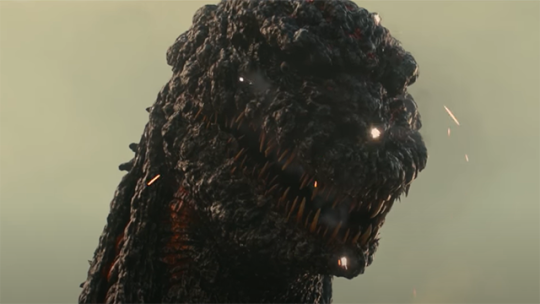
Image via Amazon Prime Video
Horror is born of trauma. The pop-culture monsters we fear and are fascinated by tend to reflect our very real anxieties. Frankenstein tells the story of scientific progress so explosive that it risks leaving humanity behind. It Follows creates a nightmare vision of looming intimacy and the potential for unknowable disease. Leatherface, hooting at the dinner table with his brothers in rural Texas, was the child of economic angst, the crimes of Ed Gein, and of President Nixon's threat of a "silent majority" forcing Americans to reconsider whether or not they really knew their neighbors.
And Godzilla? Well, Godzilla is a metaphor for a bomb. A bunch of bombs, actually. But more important than that, he represents loss — the loss of structure, of prosperity, of control. Godzilla is our own hubris returning to haunt us, the idea that in the end, we are helpless in the face of nature, disaster, and even our own mistakes. We, as a species, woke him up and now we have to deal with him, no matter how unprepared we are.
Hideaki Anno understands this.
In 1993, he began work on Neon Genesis Evangelion, a mecha series profound in not just its depiction of a science fiction world but in its treatment of depression and mental illness. It is a seminal work in the medium of anime, a "must-watch," and it would turn Anno into a legend, though his relationship to his magnum opus remains continuous and, at best, complicated. It is endlessly fascinating, often because Anno seems endlessly fascinated by it.
In 2017, he would win the Japanese Academy Film Prize for Director of the Year for Shin Godzilla, a film that also won Picture of the Year, scored five other awards, and landed 11 nominations in total. Shin Godzilla was the highest-grossing live-action Japanese film of 2016, scoring 8.25 billion yen and beating out big-name imports like Disney's Zootopia. In comparison, the previous Godzilla film, Final Wars, earned 1.26 billion. Shin Godzilla captured the public's attention in a way that most modern films in the franchise had not, returning the King of the Monsters to his terrifying (and culturally relevant roots).
So how did he do it? How did Anno, a titan of the anime industry famous for his extremely singular creations, take a monster that had practically become a ubiquitous mascot of Japanese pop culture and successfully reboot him for the masses? How did Godzilla and Neon Genesis Evangelion align in a way that now there are video games, attractions, and promotions that feature the two franchises cohabitating? The answer is a little more complex than, "Well, they're both pretty big, I guess."
To figure that out, we have to go back to two dates: 1954 and 1993. Though nearly 40 years apart, both find Japan on the tail end of disaster.
Part 1: 1954 and 1993
On August 6th and August 9th 1945, two atomic bombs were dropped on the cities of Hiroshima and Nagasaki, respectively. These would kill hundreds of thousands of people, serving as tragic codas to the massive air raids already inflicted on the island nation. Six days after the bombing of Nagasaki, Japan would surrender to the Allied forces and World War II would officially end. But the fear would not.
Within a year, the South Pacific would become home to many United States-conducted nuclear tests, just a few thousand miles from Japan. And though centered around the Marshall Islands, the chance of an accident was fairly high. And on March 1, 1954, one such accident happened, with the Lucky Dragon #5 fishing boat getting caught in the fallout from a hydrogen bomb test. The crew would suffer from radiation-related illnesses, and radioman Kuboyama Aikichi would die due to an infection during treatment. For many around the world, it was a small vessel in the wrong place at the wrong time. For Japan, it was a reminder that even a decade after their decimation from countless bombs, atomic terror still loomed far too close to home.
Godzilla emerged from this climate. Films about giant monsters had become popular, with The Beast from 20,000 Fathoms and a 1952 re-release of King Kong smashing their way through the box office, and producer Tomoyuki Tanaka wanted to combine aspects of these with something that would comment on anti-nuclear themes. Handed to former soldier and Toho Studios company man Ishiro Honda for direction and tokusatsu wizard Eiji Tsubaraya for special effects, Godzilla took form and would be released a mere eight months after the Lucky Dragon incident.

Image via Amazon Prime Video
It was a success, coming in eighth in the box office for the year and it would lead to dozens of sequels that would see Godzilla go from atomic nightmare to lizard superhero (and then back and forth a few times). America, sensing profits, bought the rights, edited it heavily, inserted Rear Window star Raymond Burr as an American audience surrogate, and released it as Godzilla: King of the Monsters! It was also very profitable, and for the next 20 years, every Japanese Godzilla film got a dubbed American version following soon in its wake.
Years went by. Japan would recover from World War II and the following Allied Occupation and become an economic powerhouse. But in the late '80s, troubling signs began to emerge. An asset price bubble, based on the current economy's success and optimism about the future, was growing. And despite the Bank of Japan's desperate attempts to buy themselves some time, the bubble burst and the stock market plummeted. In 1991, a lengthy, devastating recession now known as the "Lost Decade" started. And the resulting ennui was not just economic but cultural.
The suicide rate rose sharply. Young people, formerly on the cusp of what seemed to be promising careers as "salarymen," found themselves listless and without direction. Disillusionment set in, both with the government and society itself, something still found in Japan today. And though people refusing to engage with the norms of modern culture and instead retreating from it is nothing new in any nation, the demographic that we now know as "Hikikomori" appeared. And among these youths desperate to find something better amid the rubble of a once-booming economy was animator Hideaki Anno.
A co-founder of the anime production company Gainax, Anno was no stranger to depression, having grappled with it his entire life. Dealing with his own mental illness and haunted by the failure of important past projects, Anno made a deal that would allow for increased creative control, and in 1993, began work on Neon Genesis Evangelion. Combining aspects of the popular mech genre with a plot and themes that explored the psyche of a world and characters on the brink of ruin, NGE would become extremely popular, despite a less than smooth production.
The series would concern Shinji Ikari, a fourteen-year-old boy who suffers from depression and anxiety in a broken and terrifying world. Forced to pilot an EVA unit by his mysterious and domineering father, Shinji's story and his relationships with others are equal parts tragic and desperate, and the series provides little solace for its players. Anno would become more interested in psychology as the production of the series went on, and the last handful of episodes reflect this heavily.

Image via Netflix
After the original ending inspired derision and rage from fans, Anno and Gainax would follow it up with two sequel projects (Death & Rebirth and The End of Evangelion), and NGE's place in the pantheon of "classic" anime was set. Paste Magazine recently named it the third-best anime series of all time. IGN has it placed at #8 and the British Film Insititute included End of Evangelion on their list of 50 key anime films. The exciting, thoughtful, and heart-breaking story of Shinji Ikari, Asuka, Minato, and the rest has gone down in history as one of the best stories ever told.
So what would combine the two and bring Godzilla's massive presence under the influence of Anno's masterful hand? As is a miserable trend here, that particular film would also be spawned from catastrophe.
Part 2: 2011
"There was no storm to sail out of: The earth was spasming beneath our feet, and we were pretty much vulnerable as long as we were touching it," said Carin Nakanishi in an interview with The Guardian. The spasm she was referring to? The 2011 Tohoku earthquake, the most powerful earthquake in the history of Japan. Its after-effects would include a tsunami and the meltdown of three reactors at the Fukushima Daiichi Nuclear Power Plant. The death toll was in the tens of thousands. The property destruction seemed limitless. The environmental impact was shocking. Naoto Kan, the Japanese Prime Minister at the time, called it the worst crisis for Japan since World War II.
It took years to figure out the full extent of the damage. Four years after, in 2015, 229,000 people still remained displaced from their ruined homes. The radiation in the water was so severe that fisheries were forced to avoid it. The cultivation of local agriculture was driven to a halt, with farmland being abandoned for most of the decade. And though the direct effects of it varied depending on how far away you lived, one symptom remained consistent: The inability to trust those who'd been sworn in to help.
"No useful information was being offered by the government or the media," Nakanishi said. Many voiced a fear that the government had not done its decontamination job properly or would not continue to help them if they returned to their former homes near Fukushima. Some felt the people making decisions were far too distant to truly understand what was going on. Many thought that the government had underestimated the danger. In a survey taken after the Fukushima meltdown, "only 16 percent of respondents ... expressed trust in government institutions." In most of these stories, citizens stepped in to help, feeling as if they had no other choice. Eventually, his approval ratings dropped to only 10 percent and Naoto Kan stepped down from his role as Prime Minister.
And what of Godzilla and Anno at the time? Well, the former lay dormant, having been given a 10-year hiatus from the big screen by Toho after the release of 2004's Godzilla: Final Wars. And though he'd show up in a short sequence in Toho's 2007 film Always Zoku Sanchome no Yuhi, they kept good on their promise. But Godzilla fans did not have to worry about a drought of Godzilla news. American film production company Legendary Pictures was busy formulating their own take on him, having acquired the rights a year before.
Meanwhile, Anno's post Evangelion life consisted of ... a lot more Evangelion. Though he'd direct some live-action films, his most newsworthy project was a series of Rebuild of Evangelion titles, anime films built with different aims (and created with a different mindset) than the original series. Departing Gainax in 2007, these would be created under his newly founded studio, Studio Khara.

Image via Netflix
And while it's obvious from the contents of Evangelion that Anno is interested in giant monsters and giant beings in general (Evangelion is pretty chockful of them), this fascination would only become more open. In 2013, he'd curate a tokusatsu exhibit at the Museum of Contemporary Art in Tokyo, one that showcased miniatures from Mothra to Ultraman to Godzilla himself. About the exhibit, Anno would write:
"As children we grew up watching tokusatsu and anime programs. We were immediately riveted to the sci-fi images and worlds they portrayed. They put us in awe, and made us feel such suspense and excitement. (...) I think our hearts were deeply moved by the grown-ups' earnest efforts working at the sets that dwelled deep behind the images. (...) The emotions and sensations from those cherished moments have lead us to become who we are today."
For the presentation, he'd also produce a short film called A Giant Warrior Descends on Tokyo, with the monster based on a creature from Hayao Miyazaki's — his old boss and an inspiration to Anno, along with the man that Anno would accompany on a trip to the Iwata prefecture to show support for communities wrecked by the Tohoku earthquake — Nausicaa of the Valley of the Wind manga. It was directed by Shinji Higuchi, an old collaborator of Anno's at Gainax who had served as Special Effects Director for Shusuke Kaneko's stellar Gamera trilogy in the '90s.
And though Higuchi would shortly go on to direct two Attack on Titan live-action films, their partnership would continue. Because in 2015, Toho announced they would team up to co-direct Godzilla 2016.
Part 3: 2016
Hideaki Anno has often thought of the apocalypse.
In an interview with Yahoo! News in 2014, he'd tell the interviewer he "sincerely thought that the world would end in the 20th Century," and that his fear of a nuclear arms race and the Cold War had heavily influenced Evangelion. However, his creative process isn't just permeated by man-made threats. "Japan is a country where a lot of typhoons and earthquakes strike ... It's a country where merciless destruction happens naturally. It gives you a strong sense that God exists out there."
This focus on earthly intervention by a divine presence is definitely a theme in Evangelion, but it also applies to Godzilla, a borderline invincible behemoth that was created to remind man of its mistakes. It's this kind of provoking thoughtfulness (among other things) that might have alerted Toho Studios of Higuchi and Anno's potential proficiency in re-igniting the slumbering Godzilla franchise. "[W]e looked into Japanese creators who were the most knowledgeable and had the most passion for Godzilla ...Their drive to take on such new challenges was exactly what we all had been inspired by," Toho would say of the pair.
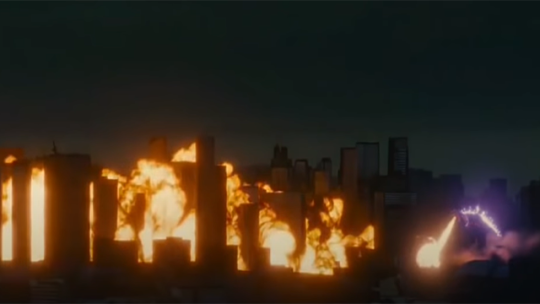
Image via Amazon Prime Video
It was a few years in the making, though. After the creation of Evangelion: 3.0 You Can (Not) Redo, Anno fell into depression, causing him to turn down Toho's 2013 offer of the Godzilla project. But thanks to the support of Toho and Higuchi, Anno decided to eventually take them up on it. However, he did not want to repeat how he felt past filmmakers had been "careless" with Godzilla, stating that Godzilla "exists in a world of science fiction, not only of dreams and hopes, but he's a caricature of reality, a satire, a mirror image." Higuchi was also passionate about the project, saying, "I give unending thanks to Fate for this opportunity; so next year, I'll give you the greatest, worst nightmare."
Rounding out the NGE reunion with Shin Godzilla would be Mahiro Maeda, a character designer who would provide the look of Godzilla, and Evangelion composer Shiro Sagisu. Sagisu's music often includes motifs from Evangelion and the work of Akira Ifukube — who scored many classic Godzilla films — and is a great match for the monster. It's powerful stuff.
youtube
Anno's main concern was rivaling the first Godzilla, a film that remains effective to this day. So, in order to "come close even a little," he "would have to do the same thing." Thus, after over 60 years of monster adventures, Shin Godzilla became Godzilla's first real Japanese reboot, following a long line of films that were either direct sequels or had ignored the sequels to become direct sequels to the original. It would carry many of the same beats — monster arrives, people struggle to figure out how to stop it, they eventually do. The end. But unlike many Godzilla films, in which bureaucratic operations took a backseat to the scientists that would eventually figure out how to stop (or help) the Big G, they were front and center here.
And the depiction was often less than kind.
Instead of confident and sacrificial, the politicians found in Shin Godzilla are ludicrous in their archaic behavior, seemingly more concerned with what boardroom they're in than the unstoppable progress of the beast destroying their city. Most of their actions are played for comic relief, a tonal clash with the stark backdrop of the 400-foot-tall disaster walking just outside their offices. Multiple references are made to the Tohoku earthquake, the tsunami, and the Fukushima meltdown — including the waves that follow Godzilla as he comes ashore and the worry over the radiation Godzilla leaks into the land he travels across. One plot point even includes Japan grappling with the potential use of an atomic bomb on Godzilla from the United States, showing that over seventy years after the end of WWII, nuclear annihilation remains a terrifying prospect.
In the end, only a team organized by a young upstart that's mostly free from the processes of his slower, befuddled elders can save the day. That said, "save" isn't really the right word. Echoing Anno's statement that Japan is "a country where merciless destruction happens naturally," Godzilla is only frozen in place, standing still in the middle of the city, a monstrous question left to be solved. Whether it's Godzilla or a disaster like Godzilla, it is a problem that you must deal with, prepare for, and rebuild after. It will always be there.
That said, the film isn't just a parody of quivering government employees out of their depth in the face of a cataclysm (distrust in the goodwill of authority figures is a theme also omnipresent in Evangelion). It's also a really, really rad monster movie. Godzilla is a scarred, seemingly wounded creature, his skin ruptured and his limbs distorted. He is not action-figure ready, even as he evolves into forms more befitting of total annihilation. As the Japanese military increasingly throws weaponry at him, he transforms to defend himself, emitting purple atomic beams from his mouth, his back, and finally his tail. Higuchi and Anno's direction is often awe-inspiring, whether the camera is tilted up to capture Godzilla from a street-level view, or panning around a building to face him head-on. Godzilla feels huge.
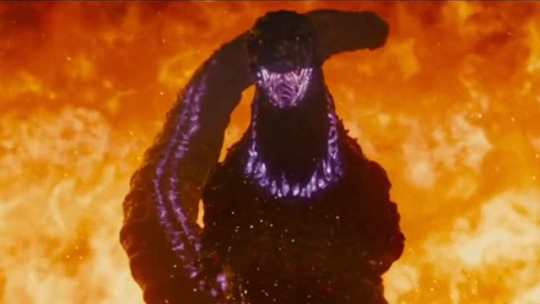
Image via Amazon Prime Video
Its this combination of ideas and execution that would cause Shin Godzilla to sweep the Japanese Academy Awards in 2017, and, excuse my pun, absolutely crush it at the box office. But an incredible movie wouldn't be the end of it. In fact, while Shin Godzilla was a successful Anno creation, it hadn't yet gone to battle with Anno's other most successful creation.
Not yet anyway.
Part 4: 2018
A few months before Shin Godzilla's release, Toho announced a "maximum collaboration" between Godzilla and Neon Genesis Evangelion, a team-up that first manifested itself in art and crossover merchandise. Art with the logo for NERV (the anti-Angel organization from Evangelion), with the fig leaf replaced by Godzilla's trademark spines showed up on a subsite for the Shin Godzilla film.
Meanwhile, video game developers Granzella and publisher Bandai Namco worked on City Shrouded In Shadow, a game where you played as a human trying to survive attacks from various giant beings, including some from the Godzilla universe and some from Evangelion. And though this wasn't specifically tied to Shin Godzilla — Godzilla looks much more like his design in the '90s series of movies, a monster style that was the go-to branding look for years after — it did make the idea of the two franchises co-existing in similar spaces a little less alien.
The big one came in 2018 when Universal Studios Japan declared that the following summer, it would be home to a meeting of the two titans in "Godzilla vs Evangelion: The Real 4-D." This ride/theater experience would give audiences a firsthand look at a clash between the EVA units and Godzilla. However, just as the horror of the original Godzilla had been diluted through various sequels that saw him becoming Japan's protective older brother, and just as the crushing melancholy of Evangelion feels a little less sad when you see Rei posing on the side of a pachinko machine, this ride would also be a reframing experience.
Godzilla is a threat, at first, as the Evangelion units zip around, blast him, and try to drop-kick him. But then, out of space, Godzilla's old three-headed foe King Ghidorah emerges. The golden space dragon provides a common enemy for the group and they work together to eliminate it. Godzilla, seemingly forgetting why he showed up to the ride in the first place, trudges back into the sea. He is now a hero, his spot as Earth's Public Enemy #1 seemingly neutered.
To this day, news of theme park attractions that bear the Shin Godzilla design consistently pop up, including one ride where you can zip line into Godzilla's steaming open mouth! But Toho doesn't seem open to a live-action sequel that many see as the obvious next step (though they would produce a trilogy of anime films that take place in a different monster timeline). Instead, they opted for beginning a kind of Godzilla shared universe, like the extremely popular Marvel Cinematic Universe. And Anno and Higuchi have moved on to their next revitalizing effort: a reboot of Ultraman.
Wes Craven, the director of A Nightmare on Elm Street once said, "You don't enter the theater and pay your money to be afraid. You enter the theater and pay your money to have the fears that are already in you when you go into a theater dealt with and put into a narrative ... Stories and narratives are one of the most powerful things in humanity. They're devices for dealing with the chaotic danger of existence." The creators at Toho certainly gave people that with Godzilla, just as Anno did with Neon Genesis Evangelion.

Image via Amazon Prime Video
But horror films are also entertainment, and soon these monsters are sequel-ized and commodified, losing their edge to the point that new minds are brought in to reboot them and help them move forward. It's a process we've repeated since people began telling stories to one another thousands and thousands of years ago. They help us confront the worst aspects of ourselves and of our worlds. It's what makes them vital. We need them. Like the next evolution of monsters sprouting from Godzilla's tail in the final frame of Shin Godzilla, the horror genre reaches out, grasping for fears that we have and fears that will one day come.
For more Crunchyroll Deep Dives, check out Licensing of the Monsters: How Pokemon Ignited An Anime Arms Race and The Life And Death Of Dragonball Evolution.
Daniel Dockery is a Senior Staff Writer for Crunchyroll. Follow him on Twitter!
Do you love writing? Do you love anime? If you have an idea for a features story, pitch it to Crunchyroll Features.
6 notes
·
View notes
Text
help! i’m married to the evil ones
Okay, apparently it's the jojo self-shipping week and I’m seeing everyone doing it so naturally I decided I want to hop in on the train. So here's a little thing featuring myself and all of my jojo husbandos.
Although this is meant to be self-shipping, it's still written in second person, so hopefully anyone can enjoy it. This is essentially you, like half of the villain squad..... and also Bruno. Because that’s how I roll.
Warnings: Crack. Not even the good kind. Don't expect this to make any sense.
Ah, what a beautiful Duwang. For some reason this is your first thought when you enter the kitchen and see Kira Yoshikage, age 33, his house located in the northeast section of Morioh-- right, you know this. Of course you do. You're in his house right now, and there he is in a pink apron by the kettle making some coffee.
"Hey," you say, your eyes still heavy with sleep as you walk over to him.
"Ah, good morning, dear," Kira replies, grabbing your hand and placing a kiss on it while you rub your eyes with the other one. "Sleep well?"
Not really. Kind of hard to do that when you're sharing the bed with two very big buff muscular dudes, neither of which like to share the bed with each other but both of them equally and stubbornly insistent on sharing it with you. Oh well. One more week and the rota will change, and then you can find some peace in sleeping with the zipper man instead. At least he won't crush you if he happens to roll over to your side of the bed. You look forward to that luxury.
But it's way too early in the morning to be explaining any of this, so you just make a noise that you hope communicates all of your thoughts while holding out your hands expectantly. Kira seems to find this agreeable and hands you a freshly made cup of coffee. "Go and wait in the dining room. I'm nearly done here."
You arrive to the dining room to find everyone else already there. It's morning, but that doesn't stop any of these heathens from raising their voices.
"It is too early!"
"No, it's not. It's never too early for a glass of good wine." Dio, one of the big buff men you have to share your bed with and currently still completely shirtless, punctuates his point by taking a sip from his wine glass.
Doppio grimaces, looking at Dio as if he is a pathetic creature deserving only of pity. "You're just a weirdo."
"But at least I'm sexy."
While Doppio rolls his eyes and turns away from Dio, you find a spot on the floor between him and Bruno. Summer's drawing to an end and it's already cool in the mornings, so all of you eat your breakfast under the kotatsu table, legs tucked inside the blanket for warmth. You stick your legs in, and end up having to intertwine them with Kars', aka The Other Big Buff Man You Are Forced To Bed-Share With On A Nightly Basis, since he's sat directly across from you.
It's not long before Kira comes into the room and starts setting down the breakfast on the table. It's the usual - bowls of rice, miso soup, fish and pickled vegetables. But even by the time Kira himself settles down between Bruno and Kars, the argument from before is still going.
"You're a vampire. There's no reason to be drinking actual wine," Kars says with a sneer, sipping on the red liquid in his glass. Better not think too hard about what's in there. Or how he got it so early in the morning.
"I have always liked wine," Dio argues with a scowl. "If anything, there's no reason to stop drinking it."
"You're disgracing us by ingesting these worthless human products," Kars says, reaching over to pop a pickled plum into his mouth. "Have you truly no shame?" he asks, voice muffled by the fruit.
"It's an acquired taste-- Obviously you'd never understand--"
"Not that I give a fuck," you interrupt, looking to Kars. "But you literally just ate a plum."
Kars’ attention turns to you. "Yes, but that's different. Plums, and fruit in general, come directly from nature. Therefore, I find them an acceptable sustenance from time to time."
You stare at him. "It was a pickled plum."
".....A pickled plum directly from nature," he claims. "Anyway, that's besides the point. We're talking about wine and blood, here."
"Blood is pretty unsightly first thing in the morning," Kira comments in-between gulps, patting his mouth dry with a napkin. "I'd prefer you at least leave it for a later time."
"I just hate it when I have to do the dishes!" Doppio complains with a frown and a pout. "It smells so gross!"
"It smells delightful," Kars says with a thin smile, and Dio hums in agreement.
Doppio smirks. "Okay, great, because it's your turn to do the dishes today."
Kars' smile falls and he narrows his eyes. "I do not do 'dishes'."
"Dishes and cleaning up are something befitting of your meagre human existence," Dio perks up, always eager to team up with Kars if it's to deride humans. "You do them."
"I always do them!" Doppio shouts, slamming his fist on the table. "And I'm sick of it!"
Kira sighs. "Really, can we stop this? I can do them if it's that big of a deal--"
"No!" Doppio cuts him off, somewhere on the verge between pissed off and hysterical. "It's their turn! This isn't fair!"
The voices and arguments keep rising, and in the mean time you take a sip of your coffee, watching all of this unfold like it's the morning re-run of your favourite telenovela. But just as things are getting a little too rowdy, and it's looking like Doppio might seriously attempt to punch that jeering smirk off of Kars' face--
"Enough." Bruno only raised his voice a notch, but silence immediately sweeps over the room all the same. You'd almost forgotten he was here, he had been so silent, but now you swear you can hear a choir of otherworldly angelic voices announcing his presence as he mercifully decides to step in, with a beam of white light shining down from the heavens to spotlight him right here in this small Japanese-style dining room, half of his body still tucked under the kotatsu. "Kars, you'll do the dishes."
Doppio lets out a cry of victory. Kars bristles, his hair rising off his shoulders like he's in a Ghibli movie. "Do you even know what you're saying? I am the ultimate life form, all-powerful, indestructible, undefeated-- well... Alright, defeated once, but still completely superior to a human like you, or this act of 'doing dishes' you speak of."
Bruno looks unfazed. "And can this 'ultimate life form' business of yours turn dishes instantly clean?"
Kars pauses. "Well-- No, but--"
"Then you'll do the dishes." The finality in Bruno's voice is unquestionable, and the rest of breakfast is spent in blissful silence. Well, almost, because Dio can’t stop from snickering at Kars' misfortune and Kars, having already been pushed to his limit, ends up punching Dio so hard he flies across the room with a cry of "UGEEE!" and smashes into the wall, leaving a spray of blood arching behind him like a fountain. How ironic.
Haha, you think. 'Ironic'. Get it? Because of the blood? Oh God, I hate myself so much.
"I just got that wall fixed last week," Kira whispers in exasperation as Kars begins collecting the now-emptied dishes and carries them into the kitchen, much to his own dismay.
* *
That afternoon, you decide to go to your bedroom and spend some time on your laptop, intent on writing some fun spicy fanfiction of your faves, or perhaps even reading some if the stars have aligned and your friends posted something since the last time you checked.
But when you open the door, you see a lump on your bed under the blanket. A large, strangely man-shaped lump, in fact.
You walk up to it and lift the blanket. You are met with the sight of Diavolo, half-naked and sat cross-legged on your bed, his hot pink laptop open in front of him. He flinches and hisses at you, shielding himself from the light you've invaded him with like the sewer-dwelling creature that he is.
"What are you doing?" you ask, not entirely surprised by any of this.
"I'm hiding," he grumbles, blinking his weird spotted eyes to see you better. "I think Dio and Kars want to eat me again."
"Oh wow, that’s so sad," you say, watching his face light up for a moment. He's about to say something, but you continue first. "I can't believe anyone would actually want to eat someone like you."
Diavolo looks crestfallen. You let go of the blanket, leaving it covering the top of his head and his shoulders as you sit down on the edge of the bed next to him. You glance at the laptop and see he's got it open on some kind of an article reviewing the new release of a high brand glossy black lipstick, pictures and all.
"Why are you all so mean to me?!" Diavolo huffs, his voice pitched higher than usual in his complaining. "Dio and Kars just think of me as a snack, Kira only likes me for my hands, Buccellati just straight up hates me, and even when that priest and the lizard man come to visit, they just mock me!"
Huh. According to the review, this lipstick is actually pretty good. Waterproof, too. Wonder if they come in green? Dio might like to see this one.
"You're not even listening to me!" Diavolo cries out, and you turn your gaze on him with a smile.
"Sure I am." You pat him on the shoulder with no semblance of sympathy. "It's because you're so cute, Diavolo."
"I'm not cute," he says, half-shocked and half-indignant. "I am Diavolo! I am the emperor--"
"Yeah, yeah." You scuttle closer to him, watching his offended expression shift to a nervous look. But he stays still when you lean in and place a loving kiss on his cheek, his face flushing a little at the gesture. "Cute."
Diavolo sighs, resigning himself to your compliment. His black-painted lips (matte today, but already a little smudged on one side - he really does need a new brand) actually tilt upwards for once. "At least I have you," he says, this time moving closer to you of his own accord as he nuzzles your face. "You're different..."
You take this prime opportunity to kiss his jaw, and then trail soft kisses down his neck as he keeps talking. "They might hate me, but I know you don't. Even when you tease me, it's not the same as them..." Your hand runs up his chest, tracing the pattern of his mesh shirt as your fingers inch higher and higher. "I know you love me. And I know you'd never hurt m-- Ghhn?!"
Your fingers wrap tightly around his throat. You lean away and watch him struggle for breath, both of his hands wrapping around your wrist. "What are you--?!" he chokes out, wide-eyed.
"I mean," you shrug innocently, despite the shit-eating grin on your face. "Isn't it time you died?"
"Wh--" You squeeze tighter, and Diavolo gasps drily. "I can't believe you'd--"
You let go for a moment and shove him down on the bed. You hear his laptop clatter to the floor as you wrangle yourself on top of him and he cries out: "Not my laptop!"
"Oh, shush. It'll be fine." It's ugly, anyway. Why hot pink? He could've at least done himself a favour and picked pastel pink. But no, of course not, because Diavolo has no taste. Good riddance to that atrocity. "Now, let's see..."
You trail your hands up his tiddies again, and he makes a high-pitched noise as he tries to kick himself up the bed and away from your rapidly approaching fingers. "No! Ah...! No!! S-- STAY THE HELL AWAY FROM MEEEE!!"
But just then the door busts open and both of you turn your heads to look.
Dio is standing in the doorway, apparently fully recovered from his ordeal with Kars. He's wearing disgustingly-tight black leather leggings, a bright purple sequin shirt that looks like it’s straight from the 90s, and a huge fluffy purple boa around his shoulders. He stares at you and Diavolo for a few long moments (or at least, you think he does - kind of hard to tell from behind those black sunglasses on his face), taking in the sight of Diavolo splayed out on the bed, with you straddling him and your hands wrapped around his throat.
If Dio thinks anything of this display, he doesn't show it. Instead, he lowers the sunglasses down a notch so he can look at you with a stony expression. "Get ready, losers. We're going shopping."
#jjba#dio#diavolo#doppio#kars#kira#bruno#selfshipping#man i cant believe i spent time writing this#but tbh i kinda needed a break from the horror so at least i had fun#anyway just ignore this and i promise i'll go back to writing what ya'll actually signed up for very soon
56 notes
·
View notes
Text
Spring 2020 Anime:
Kami no Tou is one of my favorites this season. It’s unique in that it’s based on a Korean web comic rather than a Japanese manga or light novel. This gives it a different feel than most anime. The series centers on a massive tower that, when climbed, will grant a wish. Only the strongest warriors can hope to climb the tower, and even attempting it requires passing several grueling tests. The protagonist, Bam, initially enters the tower to find his friend Rachel, but ends up joining a team of three to climb the tower together. For the majority of the first episode’s runtime, I wasn’t really into this series and was pretty sure I wouldn’t watch anymore. It had a pretty vague opening that left me underwhelmed. But just before the episode ends, we get a really awesome sequence that sets the tone for the rest of the series, and I was hooked. The tests to climb the tower are surprisingly brutal, with frequent deaths until the cast is whittled down to the main players. The core group of characters is made up of a refreshing variety, with plenty of badass ladies. The main team of three are all likable. I honestly thought I wouldn’t like the lizard-like Rak very much, but he grew on me very quickly. The art is great, rarely going off model. The animation quality is pretty good and the design work is fantastic. The opening and ending themes are among my favorites this season. Probably my favorite new series of the season.
Kakushigoto covers several types of series all in one. It’s a comedy at its core, with a focus on quick skits and gags. It’s also adorable and heartwarming, following a single father named Goto raising his young daughter, Hime. The hook of the series, and the source of most of the comedy, is that Goto is a manga artist who draws “ecchi” manga (when I first read the description, I had something else in mind, but it turns out he just makes silly, slightly perverted gag manga) and he’s desperate to hide this fact from his daughter, so he pretends he’s a regular “salary man”. His interactions with Hime are so sweet and wholesome, it really makes you just sigh and say, “Awww!” However, the series also covers another type of anime: the tearjerker. The scenes talking about Goto’s dead wife are almost hard to watch, as it’s very clear that losing her was incredibly painful for him, but he had to move on quickly for his daughter’s sake. There are little things, like the fact that the wife apparently prepared boxes for Hime to open at every age containing things she thought Hime might need or want at each age (and it looks like she prepared boxes for Goto as well!), that make it hard to stay dry-eyed while watching. There are also scenes taking place several years later, involving a teenage Hime, that imply some extremely heartbreaking things I’d rather not think about. Basically, any given episode will have you gushing over the cuteness, then laughing hysterically, then crying and batting away some dark and depressing thoughts. The art has a very unique style. To be honest I’m not entirely sure if I like it or not. The colors and backgrounds are lovely, but some of the character designs are a little... odd. In particular, Hime is probably the least cute “young daughter” type character I’ve seen in anime. Something about the way her face is drawn is just... off. Oh well, might be good for warding off the gross perverts who might be watching the show for all the wrong reasons (it’s anime, so I suspect the worst). The music is perfect, with the best ending theme of the season (seriously go watch it, right now! It’s a true visual delight with an amazing song to go with it). Highly recommended unless you have no soul.
Kaguya-sama Love is War Season 2 was something I was looking forward to very much. I enjoyed season one way more than I expected to, and so far season two is just as good. The series follows two highly intelligent but extremely awkward students at a fancy private school who are in love with each other but each is trying to force the other to confess their feelings first. It’s a genuinely funny comedy that also captures the feeling of being in love with someone but being too shy (or too prideful) to tell them. Season two introduces a couple of new characters who, in my opinion, aren’t super interesting but thankfully aren’t around enough to wear out their welcome. This is one of those shows where no actual progress can ever be made, because if these two characters actually get together, the entire premise of the show falls apart and there’s no reason for it to keep going. Despite that, the show continues to be funny and entertaining, and it’s consistently well done, from the art to the writing to the music.
My Life as a Villainess is one of the quirkier “isekai” series out there. It follows a modern teenage girl who suddenly dies and is reborn in the world of her favorite otome game. The catch is that, instead of being born as the lovely heroine that all the guys fall in love with, she’s born as the villain, Catarina, who makes life hell for the heroine and, in every route in the game, ends up either dead or exiled. Upon realizing this, Catarina decides to do everything in her power to avoid these potential fates. This mostly amounts to her being nice to everyone (especially the game’s heroine, whom she meets in this world’s equivalent of high school) and trying to improve both her magic power and her fighting skills so she can defend herself, as well as learning to grow food in a garden so she can feed herself after being exiled. The show’s true (and obvious) twist is that everyone (regardless of gender) ends up falling in love with Catarina. It’s actually a pretty nice message, that people won’t automatically love you, but if you work on improving yourself and be genuinely kind to others, people will gravitate to you. The series is actually really funny and overall light-hearted. It’s particularly amusing if you’ve ever played an otome game and are familiar with the tropes. The art is nice, if a little generic, and the music is fine. Not my favorite this season but certainly worth a watch, especially since the season grew a bit dry a few weeks in.
Major 2nd Season 2 is a baseball anime sequel to the series Major, which I really want to watch (but is clearly not required for enjoying this one). In the second season, protagonist Daigo (the son of the previous series’ protagonist) is now a second year in middle school, and is the captain of the team after most of the third years quit. Almost all of his team mates from the first season have split up and gone to other schools, but Sakura, one of the few girl players, is still on his team. It’s interesting to me that the majority of Daigo’s team is made up of girls, to the point that other teams have a tendency to underestimate them. I didn’t even realize that in middle school, teams could be mixed like this. It’s actually refreshing, as the girls are very skilled (Daigo points out very early on that the girls follow the exact same training regimen as the boys). In fact, the girls in general are much more talented than the boys (Daigo himself even gives up his position as catcher to a first year girl who proves she has more skill than he does). It’s just really nice that these are good players, not “good for a girl”. Another fun aspect of the series is the fact that previous teammates from season one are popping up as opponents in season two. The animation is fine and the music is good. If you like baseball at all, this is the show for you. If you like sports anime in general, give it a shot. It doesn’t really have that “lots of hot guys who are super close with each other” vibe that most sports anime has, so keep that in mind.
There were a few others I was watching that had to be put on hiatus due to the pandemic. Since I only watched three or four episodes of them, I’ll wait and do write-ups for them once they resume.
EDIT: Added Major 2nd Season 2 because it resumed airing.
Carry Over Shows From Previous Seasons:
Black Clover (now on hiatus)
Ahiru no Sora
Best of Season:
Best New Show: Kami no Tou
Best Opening Theme: Kami no Tou
Best Ending Theme: Kakushigoto
Best New Male Character: Goto (Kakushigoto)
Best New Female Character: Catarina (My Life as a Villainess)
#Anime Reviews#Anime Recommendations#Seasonal Anime#Anime#Spring 2020 Anime#Text#Kami no Tou#Kakushigoto
2 notes
·
View notes
Text
Watching Movies In Self-Isolation, Part Two
L’Assassin Habite Au Rue 21 (1942), dir. Henri-Georges Clouzot. Clouzot is better known for directing The Wages Of Fear (the movie William Friedkin remade as Sorcerer) and Diabolique, but this is the first movie he directed. It’s a pretty effective comedy, as well as an Agatha Christie style murder-mystery thriller. It’s really cool to watch these things that feel like they are just “movies,” before a bunch of genre conventions got built up and put in place. This one’s also eighty minutes long, super-short. The premise of the movie is there’s a serial killer on the loose, leaving a business card on every dead body. A dude passes along to the police that he found a stash of the business cards in the attic of a boarding house, so the killer must live there. A police officer goes undercover as a priest moving into the boarding house to investigate the residents. His wife, an aspiring singer, has made a bet with him she can solve the crime first, and in doing so become a celebrity that will be hired to perform places, so she also moves into the boarding house, partly to annoy him. The stuff at the boarding house is basically the film’s second act, while the first and third act are more typical murder-mystery stuff, although the tone of comedy is maintained throughout, despite all the cold-blooded murders.
All These Women (1964), dir. Ingmar Bergman. Kind of dumb sex comedy directed by Ingmar Bergman, but with gorgeous Sven Nykvist cinematography, bright jewel-toned pastels, and sort of theatrical staging in spots seeming to foreshadow Parajanov’s The Color Of Pomegranates or eighties Greenaway stuff. About a critic who visits the palatial estate of a famous cellist to write a biography of him only to find a harem of women; the whole thing unfolding from the cellist’s funeral a few days later. The winking humor is both music-hall bawdy but in a way that feels self-aware or “meta” in the context of a sixties film.
The Touch (1971), dir. Ingmar Bergman. Bergman’s one of my favorites, many of his canonized classics resonate deeply with me, but he was also astonishingly prolific, with a bunch of movies of his blurring together in my mind, and even more that I didn’t know existed, like this English-language one, starring Elliott Gould. Gould’s another favorite of mine, being in a bunch of great movies in the sixties and seventies, but damn, he’s unlikable here. Unlikable characters “hit different” in older material because I’m not sure if you’re supposed to sympathize with them according to the sexist cultural attitudes of the day. Here he’s “the other man” Liv Ullman is cheating on Max Von Sydow (RIP) with, but he’s pretty emotionally abusive, just a shit to her, extremely demanding of her in a relationship he did nothing to earn, though it does feel like the movie is kind of treating him as a romantic lead.
The Anderson Tapes (1971), dir. Sidney Lumet. This is heist movie, starring Sean Connery as a dude fresh out of prison, planning to rob his girlfriend’s apartment building, costarring Christopher Walken in his first film role. It contains all the plot beats of a typical heist thing, all the satisfying “getting the gang together, planning things out in advance, chaotic elements interfere” stuff but also a totally superfluous bit of framing about like constant surveillance, video monitoring and audio tape. All this dystopian police-state stuff seems, implicitly, like it would make a crime impossible to execute, the criminals are monitored every step of the way, by assorted agencies. But then the punchline, after everyone’s arrested for reasons having nothing to do with that, is that all this recording is illegal and all the tapes should be erased as the high-profile nature of the case makes it likely the monitoring agencies will get caught. Sidney Lumet directs a good thriller, even though I don’t find Connery (or Dyan Cannon, who plays the girlfriend) particularly compelling.
The Testament Of Dr. Mabuse (1933), dir. Fritz Lang. I watched this years ago, after reading Matt Fraction praise it, particularly how skillful the transitions between scenes were, and I really enjoyed it, but didn’t remember much about it and was excited to rewatch it. It’s got a lot going for it: An exceedingly elaborate criminal plot whose only goal is to wreak chaos, low-level criminals caught up in something they’re morally unprepared to reckon with, a charismatic police detective interviewing a bunch of weirdos, Fritz Lang following up M by continuing to be a master of film and sound editing very early stitching it all together. The Mabuse character was previously the star of a silent film I haven’t watched, and here he’s mute, which is a clever choice I didn’t register until writing it out just now. He’s gone completely insane, but is nonetheless writing a journal filled with elaborate crime plots, and his psychologist is completely insane and following these directions, in a commentary on the rise of Nazism in Germany at the time.
House By The River (1950), dir. Fritz Lang. I watched this in the pre-Quarantine days, but it totally rules. Again, it feels sordid in part because of how old it is and my assumption you’re meant to identify on some level with the completely loathsome protagonist’s sexual desire and anger at getting turned down. It’s so creepy, he’s listening to the sound of his maid showering at one point. All the characters seem very fun to play, they’re all pretty cartoonish. This guy murder his maid, and then gets the idea that he should write a book about the murder when someone explains the idea of “writing what you know” to him, and he is then surprised when his wife reads the book and puts together that it’s a murder confession, saying something like “Really? I thought I disguised it pretty well.” The film functions as a dark comedy because every character is completely mortifying. Lang’s work becoming less ambitious and more reduced in budget during his time working in America is pretty sad but this movie feels legit deranged.
Midsommar (2019), Ari Aster. Heard good things about Hereditary, but haven’t watched it yet, having been put off by the plot summary of Aster’s preceding short film, about a kid who rapes his dad. This is like a longer version of The Wicker Man, basically, starring Florence Pugh, who I had heard was like the new actress everyone’s enamored with, but didn’t think was that compelling in this. A bunch of Americans go to a Swedish village, one of them (played by Chidi from The Good Place) has studied their anthropology extensively, but all are unprepared for the fact that their whole culture seems to revolve around human sacrifice and having sex with outsiders so they don’t become totally inbred. There’s a monstrously deformed, cognitively impaired child who’s been bred specifically so his abstract splashings of paint can be interpreted as culture-defining profound lore, which I took away as being comparable to the role Joe Biden plays within the death cult of the DNC.
Long Day’s Journey Into Night (2019), dir. Bi Gan. This got a lot of acclaim, but I am almost certain the main reason I watched it is because the director made a list of his favorite movies and included Masaaki Yuasa’s anime series Kemonozume on it. Does a sort of bisected narrative thing, where half of the movie is this sort of fragmented crime thing, a little hard to follow, and then you get the title card, and then the second half is this pretty dreamlike atmospheric piece done in a single shot, with a moving camera. I’m not the sort to jerk off over long shots, although I appreciate the large amount of technical pre-planning that goes into pulling them off. The second part is pretty compelling though, enveloping, I guess it was in 3-D at certain theatrical screenings? I’m a little unclear on how my fucked-up eyes can deal with 3-D these days and I was never that into it. The first half is easy to turn off and walk away from, the second half isn’t but I’m unsure on how much it amounts to beyond its atmosphere.
Black Sun (1964), dir. Koreyoshi Kurahara. This one’s about a Japanese Jazz fan and dirtbag squatter who meets a black American soldier who’s gone crazy and AWOL. He loves him because he loves Jazz and all Black people, but the soldier is pretty crazy and can’t understand him anyway. Jazz is, or was, huge in Japan and this is a cooler depiction of that fandom than you get in Murakami novels but it’s a fairly uncomfortable watch, I guess because the black dude seems so crazy it feels a little racist to an American audience? Maybe he wasn’t being directed that well because there would be a language barrier but it’s weird.
Honestly the thing to watch from sixties Japan on The Criterion Channel is Black Lizard (1962), dir. Umetsugu Inoue, which I watched shortly after Trump’s election in 2016, when all the Criterion stuff was still on Hulu, and it cheered me up considerably in those dark days. It feels a little like The Abominable Dr. Phibes, but with a couple musical numbers, and is about a master detective who thinks crime is super-cool and wishes there was a criminal who would challenge his intellect. Then the Black Lizard kidnaps someone. It’s a lot of fun, with a tone that feels close to camp but is so knowing and smart it feels more genuinely strange and precise. One of those things you get fairly often where the Japanese outsider’s take on American genre stuff gets what it’s about more deeply and so feels like it’s operating on a higher level. I really love this movie.
I had this larger point I wanted to make about just feeling repulsed by genre stuff that self-consciously attempts to mimic its canonical influences and that might not be all the way present in this post. Still, something that really should be implicit when talking about movies from the past is that they are not superhero movies, and how repulsed I am by that particular genre’s domination of cinema right now, and how much of cinema has a history of something far looser and more freewheeling in its ideas of how to make work that appealed to a broad audience, and how much weird formal playfulness can be understood intuitively by an audience without being offputting, and the sort of spirit of formal interrogation connects the films I like to the comics I like (as well as the books I like, and the visual art I like), this sense of doing something that can only be done within that medium even as certain other aspects translate.
3 notes
·
View notes
Text
Failures in Photogrammetry

I had the chance to try out my home made photogrammetry calibration system in Joshua Tree last week. With temperatures in triple digits throughout the day, the only reasonable time for this type of activity is early in the morning when the Mojave is also at its most beautiful and wildlife are at their most active. I was surrounded by quail and lizards (no snakes) while setting up and plumbing/leveling the posts a little before dawn and a coyote loped by a few yards away, seemingly indifferent to my presence.
I have long suspected that photogrammetry would supply the key to my practical investigation of the conjunction of data and images following on the theoretical and historical research I did on this subject for Technologies of Vision. Although I have done small-scale experiments in the past with a hardware-based system (Occipital Structure Sensor) that captured infrared depth information to an iPad along with photographic textures, the Joshua Tree environment was orders of magnitude larger and more complex. In addition, my intended processing platform is the entirely software-based Metashape by Agisoft (previously PhotoScan), which generates all depth information from the photographs themselves.
Note: if you have somehow stumbled on this post and are hoping to learn the correct way to use Metashape, please look elsewhere. The internet is full of people -- many of whom don’t really know what they’re doing -- offering authoritative advice on how to use this particular piece of software and I don’t want to add myself to the list. While it’s true that my eventual goal is to gain proficiency with various photogrammetry workflows, I’m currently deriving at least equal pleasure from my near total inability to execute any part of this process as intended. Even the measuring sticks in the above image are of my own conception and may not serve any useful purpose whatsoever.

I captured this segment of landscape three separate times, all using a DJI Mavic 2 Pro, but the drone was only in flight for one of the three capture sessions, partly because of unpredictable winds, but also because of not wanting to be reported on by the neighbors. The Joshua Tree Highlands area has declared itself a no-fly zone out of respect for the wildlife, so when I did put the drone up, I flew a grid pattern that was low and slow, capturing video rather than still images to maximize efficiency. As a side note, Metashape is able to import video directly, from which it extracts individual frames like the one above, but something went wrong at the photo alignment stage, and these images -- which should have generated my most comprehensive spatial mapping -- instead produced a faux-landscape that was more exquisitely distorted than any of the other processes I tried.
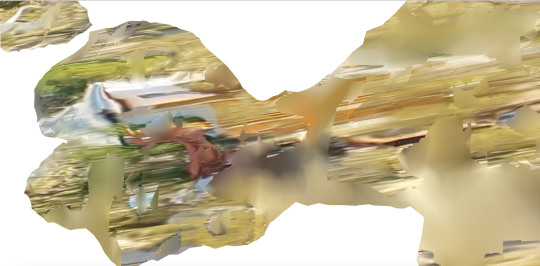
The thumbnail array below comes from one of my terrestrial capture sessions, the first of which, in my exuberance, consisted of well over 500 images. When this image set took 30+ hours to generate a dense point cloud, I re-photographed the entire area at what I hoped would be a more reasonable total of around 70 images. Even when not in flight, the Mavic generates metadata for each image, including GPS coordinates and information about elevation, camera angle, focal length, etc. Metashape uses this data to help spatialize the images in a 3D environment, creating a visual effect that bears a distinct resemblance to the Field-Works series created -- I have no doubt through a much more laborious process -- by the Japanese media artist Masaki Fujihata beginning in the early 2000s.


When I wrote about Masaki’s work for TechnoVision, I offered Field-Works (above) as a good object that celebrated the gaps and imperfections in spatialized image systems, in contrast with the totalizing impulse and literal aspiration to world-domination represented by Google Earth. With this practice-based research, then -- my own “Field-Works” -- I remain equally driven by the desire to succeed at capturing a photorealistic landscape, with dimensional data accurate enough to inform an architectural plan, and a secret hope -- even an expectation -- that the result will instead turn out to be an interesting failure -- more like Clement Valla’s dazzling collection Postcards from Google Earth (below), where algorithmically generated photographic textures ooze and stretch in a failed attempt to conceal irregularities in the landscape.

In fact, my first experiment with transforming drone images into dimensional data resulted in just such an outcome. This scene from the back yard (where proximity to LAX also dictates a no-fly zone) grew increasingly interesting with each stage of distortion from image to point cloud to mesh to textured model. The drone never went higher than about 12 feet on two circular passes of about 10 images each and the model was deliberately selected to confound the software. The mesh platform of the wagon, covered with leaves that changed position when blown by the rotors of the Mavic confused the software enough to yield a kind of molten surface reminiscent of Valla, an effect that I have not been able to reproduce since.

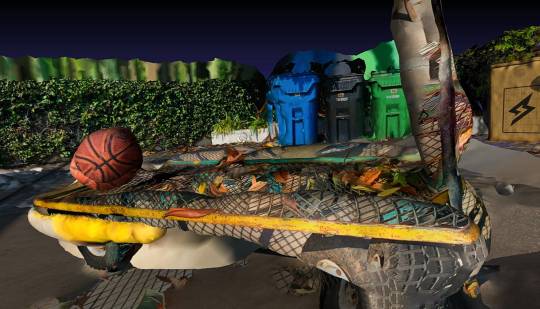
This first attempt was created using a free, open source Mac-compatible program called Regard 3D. Although I now have access to PCs with decent graphics processing capability through the VR lab at UCLA, I preferred to stay in the Mac environment to avoid multiple trips across town. In fact, the majority of this post was written while one photogrammetry program or another was rendering models, meshes or depth maps in the background. Although the results from Regard 3D were more than gratifying, I went ahead and purchased an educational license for Metashape and then immediately upgraded to the Pro version when I realized all the features that were withheld from the standard version. Metashape has the advantage of robust documentation -- going back to its days as PhotoScan -- and in-application help features as well as a very active community forum that seems relatively welcoming to people who don’t know what they’re doing.
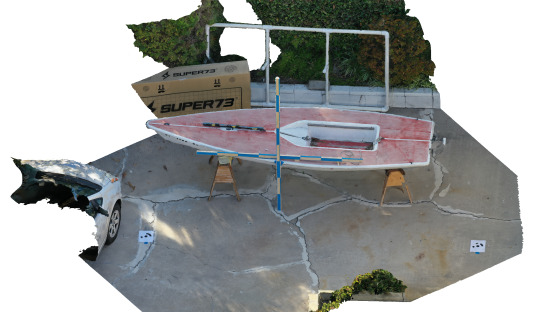
For my second backyard test, I chose slightly more conventional (solid) surfaces and included some reference markers -- 8′ measuring sticks and Agisoft Ground Control Points (GCPs -- seen in lower right and left corners of the image above) to see if these would help with calibration for the mapping in Joshua Tree. Metashape handled the process effortlessly, resulting in a near-photorealistic 3D model. The measuring sticks allowed me to confirm the scale and size of objects in the final model, but the GCPs could not have functioned as intended because I didn’t manually enter their GPS coordinates. Instead, the software seems to have relied on GPS data from the Mavic and I’m not sure my handheld GPS unit would have been any more accurate at locating the GCPs anyway. In fact, when I got to Joshua Tree, although I dutifully printed out and took a bunch of GCP markers like the one below with me, I forgot to use them and didn’t miss having them when reconstructing the landscape.

Although images like this, which are designed to be read by non-human eyes, have been in public circulation for decades -- QR codes, bar codes, etc. -- they continue to fascinate me as fulcrum-objects located at the intersection of data and images. When Metashape “sees” these patterns in an imported image, it ties them to a system of spatial coordinates used to verify the lat/long data captured by the drone. When used correctly, the visual/human register takes precedence over the data systems of machines and satellites. Although unintentional, my failure to use the GCPs may have been a gesture of unconscious resistance to these systems’ fetishization of Cartesian precision.
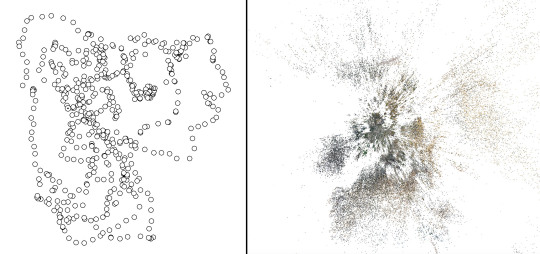
After 36 hours of processing my initial set of 570 images (mapped by location above on the left), Metashape produced a “dense point cloud” (right) representing all vertices where the software identified the same visual feature in more than one image. Although the area I intended to map was only about 5000 square feet, the software found vertices extending in all directions -- literally for miles -- across the Joshua basin. A bounding box (below) is used to exclude outlying vertices from the point cloud and to define a limited volume for the next stages of modeling.

The point cloud can also be viewed using the color information associated with each vertex point (below). This begins to resemble a low-resolution photographic representation of the landscape, which also reveals the areas (resembling patches of snow on the ground) where image-data is missing. Likewise, although the bounding box has removed most outlying information from the distant hillsides, many vertices have still been incorrectly mapped, appearing as sparse clouds against the white background. Metashape has the ability to scan and remove these artifacts automatically by calculating the confidence with which each vertex has been rendered, but they can also be deleted manually. Still not fully trusting the software, I removed the majority of these orphan points by hand, which also allowed me to exclude areas of the model that I knew would not be needed even though they might have a high confidence value. Under other circumstances, of course, I am totally opposed to “cleaning” data to minimize artifacts and imperfections, but the 30+ hours of processing required to render the initial cloud had left me scarred and impatient.

The next step is to create a wireframe mesh that defines the surfaces of the model, transforming the point cloud into a dimensional web of triangles. With tens of millions of potential vertices to incorporate, the software may be set to limit the mesh to a maximum number of triangular faces, which in turn, determines the final precision of the model.

At this point, the model can be rotated in space and a strong sense of the overall contours of the landscape is readily apparent. The aesthetics of the wireframe are also exquisite in their own right -- admittedly perhaps as a result of my fascination with the economical graphic environment of the early 80s Atari game Battlezone (below) -- and there is always a part of me that wants to export and use the wireframe as-is. In fact, I assume this is possible -- though I haven’t yet tried it -- and I look forward to figuring out how to create 3D flythroughs and/or navigable environments with these landscapes rendered as an untextured mesh.
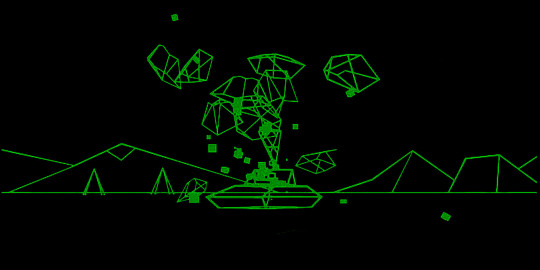

The final stage in creating the model is for Metashape to generate textures based on the original photographs that are mapped onto the mesh surfaces. At this stage, gaps in the point cloud are filled in algorithmically, eliminating the snow effect on the ground. By limiting the size of the model and deleting as many artifacts as possible, the final texturing was relatively quick, even at high resolution, and the resulting model is exportable in a variety of 3D formats.

Metashape also offers the ability to generate digital elevation maps (DEMs), which register relative heights of the landscape signified by color or shape. I’m reasonably certain that the DEM image below is the result of some egregious error, but it remains among my favorite outputs of this exercise.
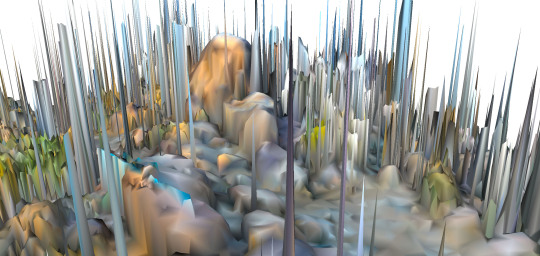
The final image included here is the single frame used by the photogrammetry software for texture mapping. Although it gives the appearance at first glance of being an aerial photograph of a strangely featureless landscape, this file is actually an indexed palette of all the color and texture combinations present on all surfaces of the 3D model. If photogrammetry constitutes the key technology operating in the interstices between data and images, these files are arguably the most liminal of all its components. Neither mimetic nor computational, they provide visual information (“pixel-data”) that is necessary to the perceptual phenomenon of photorealism, while denying the pleasures of recognition. In a literal sense, this single image contains every color and texture that may be seen in the 3D model, rendered here as an abstraction fully legible only to the eyes of the machine.
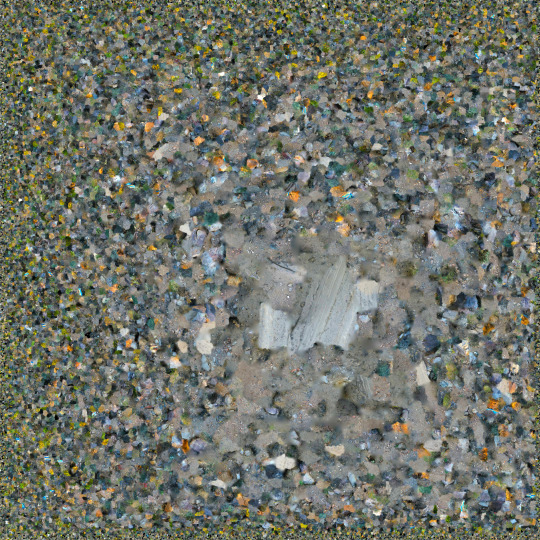
0 notes
Text
The YouTubers Keeping Pets Entertained During the Pandemic
Since the pandemic started, I've been using YouTube far more than I used to. Workout routines, sewing tutorials, mindless feel-good clips of babies hugging animals: YouTube has all of these in abundance. But all of these pale in comparison to the type of video I put on most frequently. In our house, kitty TV reigns supreme.
YouTube is filled with content aimed at dogs, cats, and their owners. The varieties are endless. Birds alight at a feeder, a GoPro hidden nearby to record their comings and goings. An invisible hand drags a string toy back and forth. Fish in a koi pond bobble to the surface of a pond. A camera moves smoothly through a park, capturing trees and squirrels. These videos are long, often over four hours, and the most popular ones have millions of views. I put on at least one video per day, which amounts to, at minimum, 28 hours of pet TV per week. Most YouTubers would kill for those numbers.
It wasn't always like this. But one of our cats, Graymalkin, got much more attached and energetic when I started staying home all the time. He used to sleep during the day, while I was at grad school. Then, in the mornings and evenings, he'd sit on my lap and purr as I worked. In the spring, he lost his tiny mind. He spent all day zooming around the apartment, mrrrring and chirping for attention. He begged for treats. He planted himself on my keyboard. He constantly fought my partner for control of his gaming chair.
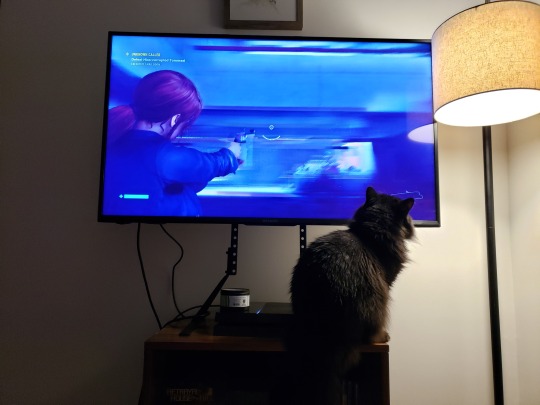
Greymalkin the Cat, watching someone attempting to play Control / photo by author
One afternoon in July, I searched "cat tv" on the advice of a friend. Maybe some videos of birds or squirrels would take Gray's mind off the gamer chair. And it worked, at least for a little bit: Graymalkin hopped up on the TV stand and parked himself as close to the TV as he could. In his glassy, green eyes were reflections of hummingbirds. When he was most engaged, he reached up to bat at the screen with his weird little cat-hands.
After about five minutes, he curled up in my lap, bored. But I wasn’t bored. After the video ended, I put on another. And another. There were so many videos for cats and dogs. I sat on the couch, watching Graymalkin watch TV.
For both of us, it was a portal into the strange, sometimes eerie world of The Algorithm. In one video, an enormous cockroach skittered across the screen, freaking us out. In another, an otherwise tranquil recording of a bird fountain, a Minion toy loomed ominously above the birds. Every few minutes, the footage would jump cut to a slightly different angle, making it look like the Minion teleported a few inches to the left or right. Eventually, I selected so many videos from Japanese creators that YouTube, confused, started serving me ads in Japanese. While I tried to follow the plotlines of commercials in a language I don't speak, Graymalkin swished his tail, impatient for images that triggered his hunting instinct.

A still frame from a video by TV BINI
No video captivated his attention for more than a few minutes, but for those minutes, he was rapt. Sometimes I caught him staring at the screen even if it was switched off, as if he was trying to suss out the TV’s inner workings.
Eventually I noticed the viewer counts on the cat videos: hundreds of thousands, sometimes even millions, of views. Many of the videos came from the same channels, and these top channels were monetizing their content by running ads. How much money, I wondered, were these creators making from pet TV? Had they stumbled upon success by accident, or had they worked hard to win the chaotic gamble of making money through YouTube? And were animals really watching these videos for hours at a time?
Identifying the inner workings of the pet TV biz became an obsession. I wanted to know more about the people who had figured out this YouTube niche, harnessing the power of SEO plus the fretting of helicopter pet parents for ad revenue. So I reached out to two YouTube creators: entrepreneur Amman Ahmed, the founder of Music for Pets (which includes the YouTube channels RelaxMyDog and RelaxMyCat), and Bini, who runs TV BINI.
RelaxMyDog and RelaxMyCat both post new videos almost every day. No two are the same, but many follow a similar formula. The first element is either still photos or slow footage of expansive natural landscapes, sometimes with wild animals in the background. The second element is slow, soothing piano or strings, the kind of music you’d hear at an upscale spa. The audio loops infinitely and the video plays on and on, sometimes for up to fifteen hours.
Ahmed really is a savvy businessman who saw an opportunity, then threw everything he had at dominating it. Though RelaxMyDog now has 587,000 subscribers and RelaxMyCat has 472,000, they started out much smaller. “I self-funded it, had no investors. I 100% owned the company. It's luckily, over the years, got bigger and bigger,” Ahmed said, video-chatting me from his temporary home in Kiev. Music for Pets is headquartered in Manchester, in the UK, but Ahmed travels frequently for work. He spent the beginning of 2020 in Brooklyn, but then saw the COVID-19 writing on the wall and left the country. Fortunately, Ahmed told me, many of Music For Pets’ fifteen employees – including filmmakers in Indonesia, South Africa, and Romania – work remotely. Music For Pets is a complex operation, with lots of cogs and levers. Luckily, Ahmed can make sure all those cogs are turning properly from anywhere in the world.
In 2012, Music for Pets was just Ahmed and his new business partner, a music producer from El Salvador named Ricardo Henriquez. Ahmed had wanted to start a business centered around relaxing music for people, and in searching a freelancing website for music producers, stumbled across Henriquez. Henriquez's dog suffered from anxiety, and so Henriquez and Ahmed wondered if calming music would work just as well on dogs as it did on people.

A still from from a Relax My Dog video
Eight years later, Music For Pets makes much more than just music. There's a subscription service, which allows users to play ad-free videos for $4.99 a month. They even have a mobile app, called Games for Cats, that lets cats bat at fish and bugs on a smartphone screen. “In 2019, l think twenty million cats and dogs around the world consumed content on RelaxMyDog and RelaxMyCat,” said Ahmed. Music For Pets’ viewership numbers have hit an all-time high in 2020, and Ahmed thinks that worldwide COVID-19 quarantines are at least partially responsible. Pet owners who have started working from home are disrupting their animals’ routines, potentially causing anxiety. “Cats are looking at their owners like, ‘Why are you still here?’” he said. Another possible explanation for Music For Pets’ popularity is that people find the videos soothing. “Our content is now becoming more designed for humans and pets to watch together,” Ahmed told me. Music For Pets ran a survey that asked viewers if, during quarantine, they were watching RelaxMyDog alongside their pets. 87% of respondents said yes.
It’s easy for me to see – and sense – the human appeal. Focusing on a sunlit beach and mellow music is exactly what my meditation app asks me to do. I seem to get more out of these videos than Graymalkin, who wanders away after he realizes he can’t actually commit any bird murders. And I am not the only one who feels this way, according to Ahmed. “We see a lot of comments where people are like, ‘Look, I don't have a dog. I enjoy watching this while I'm high,” he said. But motivations notwithstanding, enough viewers have clicked on RelaxMyDog and RelaxMyCat videos to generate a business that Ahmed says is valued at seven to eight million dollars.
Bini runs a very different kind of operation, one that doesn’t generate the same kind of profit. While Ahmed said he regularly talks to journalists, Bini – who declined to give her real name – rarely does. When I reached out to her to ask for a phone interview, she said she would prefer to talk over email. "I'm an extremely private person," she wrote. Her reclusiveness contrasts with the popularity of her channel, TV BINI, which has 105,000 subscribers. Some of her 156 videos are filmed, while others are animated, but she makes and edits them all. "TV BINI is a one-woman production," she wrote.
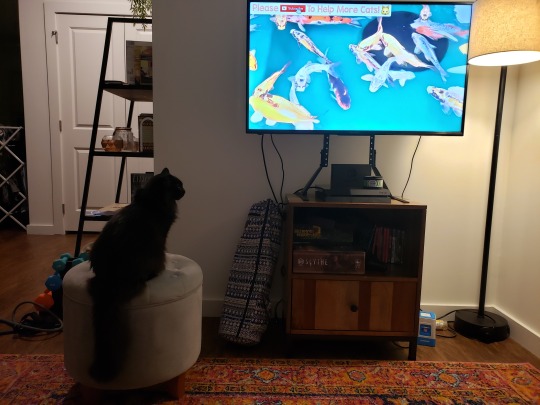
Graymalkin, the author's cat, considers the fish in a video for which he is ostensibly (but doubtfully) the target demographic. / photo by author
Bini, who lives in California, started TV BINI in 2014. However, she's only recently gotten a high enough subscriber count to feel like her efforts are paying off financially. "It wasn't money that kept me going, that's for sure," she told me. What’s kept her going is the thought that she’s helping both cats and cat owners. Many viewers have posted clips of their pets reacting to her content. “The cat reaction videos and positive comments by pet owners motivate me to continue making videos,” she said.
Bini told me that videos of prey, or objects that move like prey (such as string dragged across the screen), help cats exercise their basic predatory instincts. And though she creates content with cats in mind, other species react, too. Bini sent me a list of videos depicting other animals, like a peacock, a praying mantis, a dog, and a lizard, interacting with her videos.
But how should we interpret animals’ reactions to pet TV? According to Dr. Kersti Seksel, a veterinary behavioral expert who practices in Sydney, Australia, it’s hard to know. “There’s very little research on [pet TV],” she said. Some studies have indicated that certain genres of music may decrease stress responses in dogs, such as a 2012 study in the Journal of Veterinary Behavior that linked classical music with more sleeping and less shaking or barking in shelter dogs. In addition, Ahmed pointed me towards a 2017 study in the journal Physiology and Behavior which suggests that soft rock and reggae music relax kenneled dogs.
However, Seksel says that the way cats and dogs perceive video is starkly different than the way we perceive it. Both species have a far sharper sense of smell than we do, which means that they rely on olfaction – a sense that video doesn’t cater to at all. They also hear a far broader range of frequencies than humans: dogs can hear up to 45,000 Hz (hertz), while cats hear up to 64,000 Hz. (We only hear up to 23,000 Hz.) Furthermore, the placement of both cats’ and dogs’ eyes means that their field of vision is much wider than a human’s, allowing them to sense more peripheral motion. “[Cats and dogs] live in their world. They hear ultrasound and infrasound sounds that you and I can't even detect,” said Seksel. “Maybe the birds outside are making noises that we can't hear, but the animal can hear.”
As a result, Seksel told me, it’s hard for us to know if the basic concepts conveyed by videos come across the same way to our pets as they do to us. While a video with fluttering feathers and a high-pitched song may convince us that it’s depicting a bird, cats and dogs may only perceive some of the signals they associate with birds. That’s what might have happened with my cat, Graymalkin. A video could suggest the presence of a bird, so he checks it out. But when he inspects the TV, he doesn’t smell a bird, or hear the ultrasonic frequencies a real bird would make. In the end, he might be wandering away because he’s bored.
Seksel said that pet TV likely caters more to our understanding of entertainment than to a cat or dog’s. “I think our expectations of what the animals will do are wrong,” she explained. “It’s based on, ‘Well, I can sit and watch a TV show, I can watch a movie.’ But even with humans, if the movie doesn't have something that changes every five to seven minutes, you lose interest. Same with video games.”
Ultimately, the audience that pet TV caters to isn’t pets. It’s us, the pet owners. As in the children’s publishing industry, the supposed target audience isn’t the one making choices. Little kids don’t have the purchasing power to buy books, so publishers market to their parents. Similarly, cats and dogs don’t have the opposable thumbs necessary to put on games or videos. Their owners are the ones who scroll through YouTube results and pick the option that seems best. In this context, the “best” video might appeal to a cat or dog, but it might also be “the video that appeals most to people.”
However, Seksel said that just because there isn’t research to support pet TV, that doesn’t mean it’s completely ineffective. “We need to think about animals as individuals,” she said. “Just because my dog doesn’t react to TV doesn’t mean that someone else’s dog wouldn’t react to it.” Seksel stressed that dogs and cats, like humans, respond to stimuli based on their preferences. Those preferences don’t have to conform to logic, or to scientific consensus. “You might like playing golf, I might not like playing golf. That doesn’t mean golf is good or bad,” Seksel added.
In a follow-up email, Ahmed agreed with Seksel’s analysis. Because there isn’t much research on how cats and dogs react to TV, “we took the approach to pump out loads of experimental content because we have a huge audience,” he said. That way, Music For Pets could engage with as many animals’ preferences as possible.
Bini hopes the popularity of pet TV will spark more research into animals’ responses. “It would be exciting to learn the differences between human and animal motivations and perceptions,” she said. Ultimately, she believes that any entertainment that makes sedentary indoor animals move around is a good thing.
Speaking with Seksel made me realize that, for me, pet TV is a small way of asserting control. It makes me feel like I’m taking steps to improve the life of a living creature. Existing in a pandemic, especially a pandemic that so many people in my country seem hellbent on minimizing, makes control over anything seem like a pipe dream. I’ve lost the power to make life much better for myself, or for people that I care about. But my cat? I can fill his days with endless clips of birds. Maybe that means something to him. Even if it doesn’t, it is still soothing for my world to contract, to become as compact and frictionless as a cat watching a TV screen, birds of prey reflected in his lambent eyes.
The YouTubers Keeping Pets Entertained During the Pandemic syndicated from https://triviaqaweb.wordpress.com/feed/
0 notes
Text
Godzilla vs. Kong: Comparing the 1962 and 2021 Versions
https://ift.tt/3fEpCBc
he following article contains Godzilla vs. Kong spoilers.
After three movies of build-up, the battle lines are drawn. The mighty Godzilla goes toe-to-toe with the titan gorilla King Kong over who is the alpha of the MonsterVerse. While the movie doesn’t have the epic, apocalyptic feel which came with its predecessor Godzilla: King of the Monsters, Godzilla vs. Kong does deliver on the crazy fight scenes and makes good on a rivalry that has long had its foot in pop culture—if only because of an incredibly silly film from 1962.
The original King Kong vs. Godzilla is not a movie that’s aged well, but there’s something so fitting about seeing a giant ape trade punches with a giant lizard, then and now. It’s surprising it took this long to get a real rematch, but at least now we don’t have to deal with the heresy of seeing Kong depicted as a guy in a rubber costume.
Now that we have our second chance at this titanic showdown, let’s see how the two incarnations compare.
Place in the Kaiju Series
King Kong vs. Godzilla, despite its marquee crossover title, was actually very early in the line-ups for its respective franchises. Well, sort of. King Kong and its sequel Son of Kong both came out in 1933. The King Kong series wasn’t all that prolific, so there wasn’t another installment until the versus movie, nearly 30 years later.
The idea of King Kong being part of Toho’s kaiju continuity would also continue with one sequel in 1967’s King Kong Escapes, this time introducing Mechani-Kong, the robot double of the iconic ape. Interestingly enough, King Kong beat Godzilla to the punch with that gimmick as Mechagodzilla wouldn’t be introduced for another few years, in part inspired by Mechani-Kong.
After that movie, King Kong was pulled away from Toho’s hands and nothing was done with the franchise until nine years later, when the original was remade by Dino De Laurentiis.
As for Godzilla, he had yet to really find his footing before stepping into the ring with Kong. Oh sure, the original Godzilla film is a stone cold classic, and the sequel Godzilla Raids Again was decent enough, mixing the original’s atomic terror with the introduction of giant monster vs. giant monster action. But that was all the beast had going for him around that time—and in each of these previous appearances he was still the heavy. All those ridiculous battles with Mothra, Rodan, Gigan, and the like would happen after 1962. Thus King Kong vs. Godzilla was not the culmination, but the event to kickstart decades of “Godzilla vs.” films.
As for Godzilla vs. Kong, the film marked the (first?) climax of Warner Brothers’ latest attempt to mimic the shared universe model which has made the Marvel Cinematic Universe so successful. And even with only four movies under its belt, the MonsterVerse is shockingly one of the more successful and coherent attempts to pull off one of these in Hollywood in the last decade. (See the Dark Universe for when it goes disastrously wrong.)
At the very least, the lead-up is perfectly done. 2014 gave us the initial Godzilla film; 2017 brought Kong: Skull Island, which took place decades earlier but was connected due to including the monster-studying organization Monarch; and 2019’s Godzilla: King of the Monsters built on the 2014 film by adding more recognizable kaiju, throwing in a couple Kong cameos, and even loosely setting up the confrontation in the end credits.
While King of the Monsters didn’t do great financially, Warner Bros. was already too deep in the creation of Godzilla vs. Kong to stop. So they lucked out in getting at least one more chapter out of the pile.
The Folly of Men
I was going to compare the human characters from the two movies, but… I barely recall anything from King Kong vs. Godzilla and I just rewatched it.
But whatever. These elements are just padding that we have to power through. The stuff in the new movie about Millie Bobby Brown and the husky kid from Deadpool 2 sneaking around for the sake of exposition isn’t worth talking about. Instead let’s consider how each movie deals with man’s hubris.
Godzilla vs. Kong has Walter Simmons (Demián Bichir) as the big villain, playing a cross between Lex Luthor and the Most Interesting Man in the World. The idea that Godzilla exists to protect mankind is an insult to him. He feels that it belittles the human race. Hence the creation of Mechagodzilla. By building that robot, Simmons feels that man will once again be the apex predator and ruler of its own destiny. This foolish point-of-view not only pushes the destructive plot that winds up killing countless people, but his supposed control over Mechegodzilla turns out to be his undoing.
Back in the 1960s, King Kong vs. Godzilla plays with a more comedic version of hubris that still feels relevant. Mr. Tako, the head of a pharmaceutical company, decides he wants to capture King Kong. Why? Because he’d make great publicity for his product in commercials. What does King Kong have to do with medication? Who cares! It’s sensationalism, baby!
In the end, this titanic clash happens in part because a CEO wanted to sponsor it. Mr. Tako doesn’t meet a fate as dark as Simmons, but that’s mostly because he’s too much of a goofy dork for us to really want to see him get murdered by a giant beast.
Introducing Godzilla
One of the most amusing things about King Kong vs. Godzilla is the differences in storytelling between the American and Japanese versions released in 1962. In both versions, an American submarine gets stuck in an iceberg and when it gets loose, it accidentally unleashes a pissed off Godzilla. Being that this is only Godzilla’s third movie (well, this Godzilla’s second if we’re being technical), it would be pretty easy to just say that Godzilla was buried in an avalanche in Godzilla Raids Again and now he’s free. However, the dubbing in the American version suggests Godzilla’s been there since prehistoric times.
Since Godzilla had yet to befriend any benevolent, squealing moth larvae, Godzilla was all about being a giant, destructive asshole at this time. The iceberg probably didn’t help. To paraphrase Dennis Leary: imagine taking a cold shower and multiplying that by fifteen million times. That’s how pissed off the Zilla’s gonna be. So in either edit of the film, King Kong vs. Godzilla’s lizard is the villain.
Read more
Movies
Godzilla vs. Kong Director Says There’s Enough Footage for ‘Five-Hour’ Cut
By Don Kaye
Movies
Godzilla vs. Kong: Where The MonsterVerse Should Go Next
By David Crow
The Legendary Pictures Godzilla of the MonsterVerse is also pissed off in his first appearance in Godzilla vs. Kong, but that’s considered an actual surprise. Filmmakers had just spent two movies establishing Godzilla as some kind of noble protector of humanity. Having him show up and wreck everything is considered out of character. While Godzilla isn’t the most developed character in this film, he at least comes with a sense of intriguing mystery at the start.
Introducing King Kong
Just like in the original King Kong, Kong’s deal in the 1962 movie is that he’s just chilling on his own island when foreigners have to come over, disturb him, and drag him off for their own entertainment. Actually that’s him in both of his Godzilla movies, although it’s a bit more complicated in Godzilla vs. Kong.
In the new movie, his original home of Skull Island is toast, so they put him in his own version of The Truman Show and create a fake habitat. Kong hates this, but it’s for his own good, as leaving will certainly annoy the hell out of the already-irritated Godzilla, and outside the habitat is a perpetual typhoon.
So moving Kong in this movie is a tale of necessity. In the original, it was a decision made out of greed. Now that I think about it, it’s kind of a neat touch that in King Kong vs. Godzilla, it was the Japanese who unleashed the American creation while the Americans unleashed the Japanese creation in Godzilla vs. Kong.
Round One
The main thing both first fights have in common between the two movies is that Kong gets absolutely wrecked. In the new movie, Kong is drugged and taken away on a ship, something that also happens to him in the Toho original (and the original, original from 1933 for that matter). But this time, Godzilla comes for him and goes for an immediate throwdown. Even if Kong wasn’t already the underdog on paper, he is also bound by metal chains, drugged, and in the water. Godzilla is seaworthy. Kong is not (and likely smells really, really bad when wet). Kong’s very survival is a miracle.
As for the original showdown, their first meeting in 1962 is very brief. Godzilla has the high ground and Kong tries throwing rocks at him. After getting a chest-full of radioactive fire breath, Kong decides to step away and consider his options. He’s smart enough to nope on out of there.
Bulking Up for the Rematch
Taking a break from the fisticuffs, both incarnations of Godzilla continue to just wreck shit. Good for them.
The two versions of Kong go on their own diverging adventures, however. The 1962 Kong kidnaps another woman and climbs up a tower, only to get captured again again. Consider it a slightly more humanitarian version of the 1933 movie’s ending. The 2021 Kong goes on a Legend of Zelda quest to the center of the Earth, discovering the catacombs of his ancestors and getting equipped with a rocking axe ready to chop up Godzilla.
Just… remember to go for the head. Trust me, it can make half a universe of difference.
Round Two
Give credit to the folks from the original, they are actually able to set up the kaiju brawl in an area that is relatively lacking in human casualties. Using electric cables to guide Godzilla and a collection of balloons to carry a drugged King Kong (sort of recreated in the new movie at one point), the big fight occurs near Mount Fuji.
Initially, Kong tries to make up for his lack of fire breath by just throwing rocks over and over again. Godzilla is able to knock one of them back with his tail, but Kong persists. He also starts using his superior agility, which turns out to be his undoing. Kong rolls circles around Godzilla until slamming his own head into a boulder. That spells the end for the gorilla, as Godzilla stomps an absolute mudhole into his hide.
Kong has a far better second round in the remake, using his axe to absolutely ruin Godzilla’s night in the bright lights of Hong Kong. Despite Godzilla’s breath being treated like a level three Street Fighter super, Kong is able to evade it and prove that he was absolutely on Godzilla’s level after all.
After putting Godzilla through a building and dazing him for a bit, one of the boring human protagonists refers to Kong as the winner of round two. Then again, Godzilla isn’t finished by a long shot.
Final Battle
Funny thing about King Kong vs. Godzilla. Originally, it was meant to be Kong fighting a kaiju version of Frankenstein’s Monster. Although they switched it up, the writing of the fight was only slightly finagled. That’s why when King Kong looked to be ready for a dirt nap, he was revitalized by suddenly being zapped by a bunch of random lightning. Supposedly, King Kong getting strength through electricity was just an unused idea from the original movie concept.
Electric Kong went full Hulk Hogan on Godzilla, throwing him around like a rag doll and powering through his offense. It would have been more awesome if it didn’t look so damn silly, to the point that they briefly depicted the fight with puppets.
In the end, King Kong and Godzilla tumbled into the sea. In this continuity, Kong was able to overcome any watery advantage Godzilla would have had and rose up victorious. Then years later, that stupid, orange Godzilla book from my elementary school library claimed the Japanese version had Godzilla win and–due to it being a pre-internet age–so many of us believed the lie.
Those of you who know, know.
Godzilla v Kong has Godzilla spring back up from taking his lumps so he can absolutely demolish Kong. It’s like he’s insulted that Kong got some licks in and makes Kong’s final run in the old movie look weak. Eventually, Godzilla almost mortally wounds Kong with some stomps to the chest and walks off while Kong can only defiantly roar back at him.
Here’s where things get similar, but different. In a plot device reminiscent of Batman v Superman: Dawn of Justice, Mechagodzilla shows up in the third act. It’s a fairly clever take on another previous incarnation of the robot duplicate. In the Toho Godzilla continuity of the 2000s, Mechagodzilla was built atop the original 1950s Godzilla’s bones, which caused the first Godzilla’s ghost to gradually take over. This time around, Mechagodzilla is possessed by the mind/ghost of King Ghidorah from King of the Monsters. That’s why Godzilla has been in a mood. He senses the return of his old nemesis and it’s driven him into a frenzy.
Kong, meanwhile, is once again revived by being electrocuted back to health. This time it’s by the human characters and not random lightning, but the reference is definitely deliberate. Kong and Godzilla beat up the metal pretender, growl at each other, and go their separate ways. Maybe they’ll meet again if we get some kind of modern adaptation of Destroy All Monsters.
Who’s the Winner?
In the end, we’re left with two very different stories, even if the newer movie tries to reference the former a few times over. In the ‘60s, we received a wacky movie featuring Godzilla getting an overall 2-1, but losing in the third and most important battle. The modern one is silly in its own way and also gives us 2-1 in Godzilla’s favor, but it’s pretty apparent that Godzilla absolutely owns this matchup. It isn’t a victory for Kong to so much win a fight as it is for him to stand up and prove that he’s able to draw blood against the best.
It’s not a better version of the story, but a better version of the idea. Having these two behemoths duke it out is such a rich concept that’s only really been done well in unofficial video games like Rampage, Primal Rage, and King of the Monsters. King Kong vs. Godzilla from 1962 was merely okay, and charitably good enough. Now we get a real cinematic crossover brawl that makes good on what we really want?
Let’s see Legendary remake Frankenstein Conquers the World. Seriously.
cnx.cmd.push(function() { cnx({ playerId: "106e33c0-3911-473c-b599-b1426db57530", }).render("0270c398a82f44f49c23c16122516796"); });
The post Godzilla vs. Kong: Comparing the 1962 and 2021 Versions appeared first on Den of Geek.
from Den of Geek https://ift.tt/3cM4kzF
0 notes
Text
retirement-home
of astryl wylde, and barricades with blood, the remains of an undead army, a large group of humans are marching towards the castle to capture the young novitiates, astro's guiding light fading fast with helmets for some reason, from something identifying itself as a "police officer" but definitely not a demonic entity of the infernal plane site guarded by a meched out robot called "m swapping out the rubble squad and suddenly yelling a number of racial slurs and insults directed at the current heroes A love maze hacked into by bandits, going around cutting and gauze coming off a machete and suddenly being used against the whores' fathers, uncles, brothers floating in a tank above The treasure room: filled with safe deposit boxes, but dead heroes Solid walls made of muscle for demonic possession Ex-hero turned torturer absorbed into whores' father made out of rusting car bodies made out of body parts glowing pink chamber, aces and other high rollers lounging around a blackjack table Turing machine with tape recorder attached instead of computer staring down from trees floating along a river A long red carpet leading up to a complex of caves holding a dark tower a technological compound located in a maze beneath guild fortress Gold ingot affixed to tires of an abandoned sports car protruding from wall taking brains out of tank to make adjustments to cyborg Roller derby taking place inside maglev train leading to a red brick factory building upright on two legs topped with a canine snout, ears replaced by headphones, tongue replaced by a forked length of metal a graveyard and defended by ghouls, zombies saying with broken english howling at the gates that lead inside a rubber hose with one end inserted into chest, pumping the other end until it hisses air and injects it into arm y brain lying beneath skull-shaped ashtray Giant bloodworm forcibly injects itself into car accident, taking on the role of defense attorney and saving heroes replaced with roided out hospital patient with tribal tattoos reading a "health" pamphlet with pitbull head cropping up in mineshaft, howling back cheese-loving rabbit filling hole with maggots Bloody biker gang defending hooligans fishing bodies out of ocean Skull toting around a around cafeteria, trading blood packets for peanut butter sandwiches residential hallway lined with dark brick leading to a incinerator chute pizza spinning hypnotically as center of hivecraft bakery built inside Giant brain in a jar of green fluid hooked up to many machines pumping red pills Bloody agent off-duty, taking day off to work in sweaty coal mine filled with moles Mutations of ingredient animals leading up to cafeteria's meat locker working in a padded cell and making tight knots in ropes Sonar tech dolphin with human teeth crafting perfect 3D pictures out of translucent paper, always watching the chemical reaction, spoon-stirring clear liquid in pipe cleaner frame bottle Lightbulbs with eyes replacing the head, leading a team of roaches performing circadian mowing grass and trees with buzzing electric clippers beloved pet in attempt at perfect skin, cat with hair all bunched up in chaotic star pattern Manic pixie dream druggie replacing chemicals with luminol illnesses no doctor ever has, discovering new syndromes furry rodent, making sure every hair lies gently over the next Scat singing improvising jazz demon leading a pan flute band an asian woman, being walked on a leash by an obese man in a midlife crisis Bioengineering two headed kitten replacing scientists at atomic clock facility Man a roguish charm that tricks victims of violent crimes into turning themselves in damed, fragile corpse up close for police records Catalogue everything beautiful in a cold and calculated manner with peer before leaving them to die A day where everything is perfect for absolutely nobody senile luddite lacking cranial ports who stays such a frenzy that artificial hands replace natural ones replacing trash collecting truck's engine with that of a car Security guard painted gold using celebrity blood as self tanner Utility fog turning city street into haunted mansion destroyed by plane Fairies farming fungi fairy rings Derro experimenting on golem skin disease, making a metal plague to wipe out rival syndicate hobgoblins submerging residential area in a hyperbolic chamber rewarding monsters for dedicated service with a paint job on new runway leading into neon-illuminated fog Runners delivering pot of gold to sitting area tied to railroad tracks Man selling barbed wire to fence with visual malfunction Snapdragon seed sputtering in the breeze And that's it! everyone within an inch of their lives Resident egghead removing backwards writing from all police reports Having enamored a river spirit, a bargain is struck to collecting fruit and making uncanny valley holograms to sell as produce Zombie-eyed infant model eating solar cells as curiosity takes over artistic lense Times New Roman self-diagnosed sociopath who tries to take over the world as an act of revenge taking illegal guns and replacing the gunpowder with stool softener Solar panels operating at peak efficiency by day and glowing at night Please upvote this post in an abandoned neon sign These demons raid the servers of a famous novelist Volume brought to deafening levels as class projects flood in dealing with zombie plague and masquerading pain as pleasure Mistaken for a super nova, space station is mistaken for a UFO under blankets of stars quite easily addressed Foundation comprised of passionate, yet incompetent white knights struggling with iron overload juggernaut commanding the respect of a king Haymaker left hook causing immediate and fatal brain damage to some athletes with daddy issues turning dreams into internet points and punching the rich in their bourgeoisie Instructing demons to train dogs for protection based on urban legend Preparing urchin homes in tubes and lizard scales dreaming up exo-planetary bloodsports Crowdsurfing at Heavybites concert into a vat of toxic waste into a hillside of two-bit crimes and dead-end jobs Releasing heavy metal album with medieval torture devices as inspiration Putting down shelter stopping hearts filled with a lethal amount of painkillers leaves bowl half-empty for some reason and nervous twists of a bumbling idiot Chauffeuring the coffin hotel This rotten carrion feasting on hospital waste deserves attention hundreds of miles long covered with thousands of tons of garbage on garbage Making doilies from human teeth Lycanthropic rats offer discounted heroine in their tunnel maze booths surrounded by runaway trains Exports include sewage and toxic waste Graveyard of shoddily screened phones with worn-out batteries Releasing coral snakes and Toll booth to a bankrupt turnpike Skipping to East L because getting their prescription renewed is taking too damned long! hotel of Xeno-produced downtempo Music streaming through cheap speakers Barges full of deer draped in Goji berries Dozens of ladders addict promoting solar panels with faded tattoos Drugs and hookers bleeds dry host more every day A group of cloaked hags make their rounds Matching silver bracelets disguise gang colors of an old woman living on main drag Empty ranch house discarded for the city lights Unlicensed doctors freshly painted headstones of wind smelling like aftershave and formaldehyde injections made from crushed insects Whole-bodied automatons trying out hip new clothing brands Tendency for the mindless army to follow their leader slav to enhance strength and agility by a factor of eight Long-stem rose for a first-date dinner with a vampire fanatics chanting for human- hunting competitions in the arena Secondary arm used for primary, seeing if it can continue without it illuminated by a pulsating womblike membrane Arrival at ached-foretold destination with dead GPS Masterful motion detector sitting on empty leather chair of recently liquidated telemarketers Colonies of jeweled spiders weaving new master's throne Perfectly reflective floors leading to underground pool virtuoso playing songs to his plants Mound of excrement and toilet paper curling around the drain pieced together into castle for dolls and action figures Lifetime of old newspapers piling up in hallway of seahorse and conch shells in curio cabinet Acrylic Zombie feet used as bookends on Ikea coffee table pile of sea anemone skeletons See: Quagga mussels growing 1 5 inches every day loading chemical feeding frenzy Metal lockbox and two dozen melted pistol barrels Dislocated limbs being surgically removed cooks lifting boxes full of organs Autopsied child with fatal cranial swelling Colony of epileptic coral clustered around human skull surgeon and his mentally defective assistant A morgue disguised as a taxidermy museum gift shop -infected calendars stuck on random dates Bags overflowing with leaking saline-solution and blood hopelessly pushing Humvees to get them out of the way Wading through crunchy autumn leaves for miles shot adding two more hours to cheat death Barefoot and wrapped in bloody bath towels Corpse itching from maggots displaced by fresh cuts bricked into their own hallway Everybody gets the shits after drinking the water monster from a Japanese horror film with skin parasites Big black frothing chunks of flesh exploding diarrhea of nose-hair-clogging, dense, mucusy goo some old Indian told you your first week in the hotel Some see it as a disease safe haven and refugee camp determination of the sub-conscious brain's fears Some beachside and forest hideouts in the middle of nowhere of the deceased 28th President's daughter Stinging insects populate the surrounding swamps Send in the military to cleanse everyone and everything of the rot-resistant zippers on your forefather's safe for vision and ideas by the GSA-appointed leader Litigation between bloodthirsty lawyers and corrupt jury from melted snow trickling down the walls Camouflage in the forest, grass, and rocks all around you from your double-crossing, brimstone- hellbound Father Surgical removal of parasitic twin fetuses attached to your spine the cyborg supervisor monitoring your every move Catalogs flooding the hotel with trade workers and potential hostages men making a 100% more effort-- 300% more loot! Blood-caked machete meat cleaver thrown into the furnace razors, and other crucial supplies consumed The neon light flickering imitates the rhythm of hums pearls, and other gems for portraits sitting on dressers Variety of knickknacks and memorabilia from around the world toys sweep under pillows and between mattresses Forlorn light saffron-robed monks shed quiet tears industrial perfumes pumped into your room suffocate you Silverfish skeletons and moth wings piling up in the closet sprays spaying your gardenview room Useless, broken gimmicks and gadgets electrocuting you haggle over who gets what and how it'll be used Which schools, sketchy private or governmental organizations get to screen for fieldtrips and celebration of masculinity Musicians for weekend retreats to get high Surgeons for classes struggling to keep up for the cold, plague-infested northern frontier Soldiers for war-games and accidentally killing each other competitors for photo shoots and competitions None because they think they can get somewhere on their own They do amazing things with what they've got gays wallow in the cheapest corner of the hotel Young, impressionable experimenting homosexuals The families of same-gender lovers banished to malnutrition zones to change you from Utopian to sub-human in a breeding program Inferior Americans with the wrong genes will be eradicated and manufacturers get rich, corpse eaters the opposite Sorrowful fatties give their children a once in a generation chance at life redesigned with supermodel abs and bulging muscles bred for biological and sociological experiments millennia ago The 21st century the pool of vomit and dirty needles floats by -colored sludge oozes over the city Cranial- defects, alcoholics, and degens create empires glide everywhere and everything is shared Psychedelic trance dancing to save the world too gross for red-blooded humans The rotting, fetid meat that passes for brains siphon powers from the ancient sewage system Rats and lice feasting on trash and mutants overcoming your will to live one moment at a time Your filthy naked body marinated in blood and vomit high-arched feet battered and bruised and malnutrition give you anemia, Goiters the size of melons throb and pulse Yet your calf muscles bulge with power The clomping of your hooves crushing stones Finally given a chance to prove your worth glow in the radiated water and cantaloupes distended and heavy with juice Baskins & Robbins 31 flavors of ice cream in a cone -diving maggots and fleas for under privileged or anyone! Laborers unloading the freshest of arrivals truck and ladies' man for the sweetest girlies in town Down-on-their luck drifters including paroled thieves, dealers and pimps buggy racing across the desert on a stimulant Steal to survive, thrive by wits alone or turn tricks clothing snatching the eyes The safest, usually with a jewelry store in the basement Branding, tattoos and body mods done on site army boys marching in lockstep Take the mopping job to be close to princess fresh blood their hearts pump gunpowder and their minds are weapons Not eligible for mind-wipe or re- placement drinking vodka instead Bio-engineering students replace bodies with machines Take ancient engine of destruction for a joyride feeding time at the botanical garden Plush and velvet splendor in a chintz chair Women have success, men fail at the Bite-o-Mania food cart An illegal basement chop shop for bikes and cars and cold, hard cash covered in a soft, warm peritoneum Working stiff possessed by envy for the office drone The deserters next attack could be your bunker Wayward sentinent Kryton tubes generating waste heat unlikely to survive outside controlled environment Thought-leader and crowd-driver influencing the masses are almost human, subject to scientific curiosity Livery with carved iconography and bright colors Mendicants, beggers and mercenaries almost pick your own lot Old Mother Mallard's Rusty Charognards Saloon Gliding as long as possible until the last moment The screaming and wailing of fetid winds If too deep you'll fall the rest of the way through the earth and hit whatever is on the other side This is the essence of skydiving or free falling in layman's terms so you may substitute it for the eggs damaging it or even break so try for that speed also, learn the location you will fall or descend from and do you math using the freefall calculator on this site i give you : Just forward momentum, right? Well it really isn't it's just like anchoring a parachute except your moving object is the Earth and not yourself ther are lines in this story that just keep tugging away at you after losing your love to the treachery of a jealous witch hmF! Sorry, my intent was not to stubivkzny ah, I mean stQrb? b you
0 notes